HARRIS TR-410-A2 Portable Amps CDMA User Manual exhibit 8
HARRIS CORPORATION Portable Amps CDMA exhibit 8
HARRIS >
exhibit 8

Draft - Not for Commercial Use - Ericsson Inc.
Register your new phone, purchase Ericsson original accessories, and see the latest in products by visiting us at:
www.ericsson.com/us/consumer
9/00 PBM
This manual is published by Ericsson Inc., without any warranty. Improvements and changes to this manual necessitated by typographical
errors, inaccuracies of current information, or improvements to programs and/or equipment, may be made by Ericsson Inc., at anytime and
without notice. Such changes will, however, be incorporated into new editions of this manual.
"Ericsson", "Ericsson " and "ERICSSON ORIGINAL ACCESSORIES" are each registered U.S. Trademarks owned by Telefonaktiebolaget
LM Ericsson of Sweden.
EZ-Read Menus is a registered trademark of Ericsson Inc.
“Tegic" and "T9" are each registered U.S. Trademarks owned by Tegic Communications, Inc. of Seattle, Washington, U.S.A. The T9® text
input product is provided under license from Tegic Communications Inc. and is covered by U.S. Pat. 5,818,437, U.S. Pat. 5,953,541, U.S.
Pat. 6,011,554 and other patents pending.
© 2000, Ericsson Inc. All rights reserved.
Publication Number: AE/LZT 123 5633 PA5 (Beta)
Printed in USA
A1228c User’s Guide
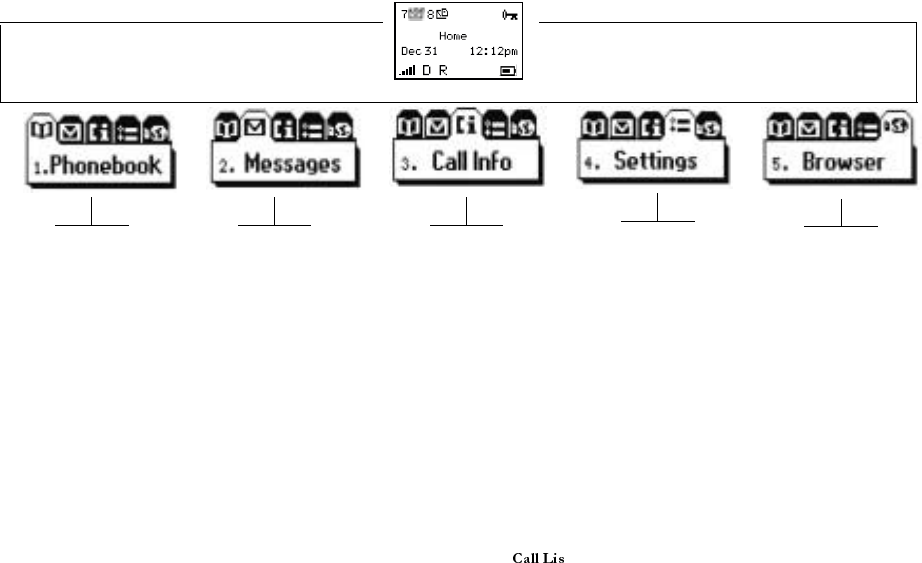
Draft - Not for Commercial Use - Ericsson Inc.
1 List and Call
2 Add Entry
3 List and Edit
4 My Number
5 Find Entry
6 Scratchpad
7 Auto Hyphenate
8 Delete All Entries
1 Voice Mail
2 Message Inbox
3 Message Outbox
4 Send Message
5 Memory Used
6 Delete All
1 Call List
2 Home Usage
3 Roam Usage
4 Total Usage
5 Clear Call Lists
1 Sounds
2 My Number
3 Keypad Lock
4 Call Options
5 Security
6 Language
7 Display
8 System Options
1 Launch Browser
2 Text Size
3 Alert Sound
4 Network
You can quickly access the menus by pressing the MENU key. The menus are arranged in a continuous loop. Quickly access menus and settings using
the numbers that appear next to each menu and setting. For example, access t submenu by pressing MENU and then 3 1. Press YES to select a
menu, submenu, or setting. Press NO to exit the menu or submenu.
Some menus/features are operator dependent.

Draft - Not for Commercial Use - Ericsson Inc.
i
The Basics . . . . . . . . . . . . . . . . . . . . . . . . . . . 1
Document Conventions . . . . . . . . . . . . . . . . . . . . . . . . . .1
Highlights of Your Phone . . . . . . . . . . . . . . . . . . . . . . . . .1
Getting Started. . . . . . . . . . . . . . . . . . . . . . . . 4
Parts of Your Phone . . . . . . . . . . . . . . . . . . . . . . . . . . . . . .4
Connecting and Removing Your Battery . . . . . . . . . . . . . .4
Charging Your Battery . . . . . . . . . . . . . . . . . . . . . . . . . . . .5
Turning Your Phone On and Off . . . . . . . . . . . . . . . . . . .6
Making and Receiving Calls . . . . . . . . . . . . . . . . . . . . . . .6
Operating Your Phone . . . . . . . . . . . . . . . . . . . . . . . . . . . .7
Voice Operation . . . . . . . . . . . . . . . . . . . . . . . 8
Your Display in Voice Operation . . . . . . . . . . . . . . . . . . .8
Main Menu . . . . . . . . . . . . . . . . . . . . . . . . . . . . . . . . . . . .9
Phonebook Menu . . . . . . . . . . . . . . . . . . . . . . . . . . . . . . .9
Messages Menu . . . . . . . . . . . . . . . . . . . . . . . . . . . . . . . .10
Call Info Menu . . . . . . . . . . . . . . . . . . . . . . . . . . . . . . . .11
Settings Menu . . . . . . . . . . . . . . . . . . . . . . . . . . . . . . . . .12
Browser Menu . . . . . . . . . . . . . . . . . . . . . . . . . . . . . . . . .14
Voice Operation Display Messages . . . . . . . . . . . . . . . . .15
Voice Operation Key Functions . . . . . . . . . . . . . . . . . . .15
Voice Calls . . . . . . . . . . . . . . . . . . . . . . . . . . . . . . . . . . .16
Using Your Phonebook . . . . . . . . . . . . . . . . . . . . . . . . . 18
Short Message Service (SMS) . . . . . . . . . . . . . . . . . . . . . 19
Browser Operation . . . . . . . . . . . . . . . . . . . 22
Browser Operation . . . . . . . . . . . . . . . . . . . . . . . . . . . . . 22
Your Phone’s Display in Browser Operation . . . . . . . . . 23
Accessing the Browser Menu . . . . . . . . . . . . . . . . . . . . . 23
Working within the Browser . . . . . . . . . . . . . . . . . . . . . 23
Browser Status . . . . . . . . . . . . . . . . . . . . . . . . . . . . . . . . 27
Wireless Modem Operation . . . . . . . . . . . . 30
Wireless Modem Operation . . . . . . . . . . . . . . . . . . . . . . 30
Differences Between Data, Fax, and Internet Calls . . . . . 30
Before You Start . . . . . . . . . . . . . . . . . . . . . . . . . . . . . . . 31
Setting Up Your Computer . . . . . . . . . . . . . . . . . . . . . . 31
Initial Setup . . . . . . . . . . . . . . . . . . . . . . . . . . . . . . . . . . 31
Operation . . . . . . . . . . . . . . . . . . . . . . . . . . . . . . . . . . . 32
Achieving Best Performance . . . . . . . . . . . . . . . . . . . . . . 34
Installing Your Modem Driver From Your Compact Disc 34
Manual Installation of Your Modem Driver
or Voice Call Dialer . . . . . . . . . . . . . . . . . . . . . . . . 35
Troubleshooting . . . . . . . . . . . . . . . . . . . . . . . . . . . . . . 36
Table of Contents
Draft - Not for Commercial Use - Ericsson Inc.
ii
Troubleshooting . . . . . . . . . . . . . . . . . . . . . 38
Problem Solving . . . . . . . . . . . . . . . . . . . . . . . . . . . . . . . 38
Accessories, Accessibility, and Internet . . . . . . . . . . . . . . 39
Guidelines for Safe and Efficient Use . . . . 40
Safety . . . . . . . . . . . . . . . . . . . . . . . . . . . . . . . . . . . . . . . 40
Product Care and Operation . . . . . . . . . . . . . . . . . . . . . . 42
Battery Information . . . . . . . . . . . . . . . . . . . . . . . . . . . . 43
FDA Consumer Update . . . . . . . . . . . . . . . . . . . . . . . . . 44
Glossary . . . . . . . . . . . . . . . . . . . . . . . . . . . . 50
Index . . . . . . . . . . . . . . . . . . . . . . . . . . . . . . . 53

Draft - Not for Commercial Use - Ericsson Inc.
The Basics 1
Document Conventions
•Menu names are shown in the following typeface: MENUS.
•Submenu names are shown in the following typeface:
ubmenu
Names.
•Key names are shown in the following typeface: BACK.
•Text that is seen in the phone’s display is shown in the following
typeface:
Displays
.
•When this guide instructs you to press a key, press and release the
key.
•When this guide instructs you to press and hold a key, press and
hold the key for one to two seconds.
•When this guide instructs you to press two keys, press one then
press the other. For example, press MENU 1 means press MENU
then press 1.
•Press the down arrow on the rocker key when you see this symbol
().
•Press the up arrow on the rocker key when you see this symbol
().
Highlights of Your Phone
Your Ericsson mobile phone features dual-mode technology. For
Voice Operation, it operates in two modes - Digital ( ) mode (800
MHz frequency band) and Analog ( ) mode (800 MHz band).
Some features and services described in this user’s guide are content
provider specific. Refer to your content provider for more informa-
tion.
Banner
You can customize the banner to display one line of text. See
“Change Banner” on page 14.
Caller Identification Service
The Caller ID service identifies, by name or number, who is calling
you. See “Caller Identification” on page 17.
Call List
The Call List identifies the last 45 received, missed, sent calls, or
numbers entered in the scratchpad. See “Call List” on page 11.
Call Forwarding
Call Forwarding lets you forward your voice, fax, and data calls, pro-
vided your subscription supports fax and data calls.See “Call For-
warding” on page 17.
The Basics

Draft - Not for Commercial Use - Ericsson Inc.
2The Basics
Call Waiting
Call Waiting allows you to receive a second incoming call while you
are already engaged on one call. See “Call Waiting” on page 17.
EZ-Read™ Menus
Makes menu navigation and changing settings simple. The tabbed
menus clearly show the way. Use the rocker keys to scroll through
the menus and menu settings. See “Main Menu” on page 9.
Keypad Lock
Helps you to avoid accidental dialing, which can happen if you keep
your phone in your pocket or pocketbook. You can quickly access
keypad lock by pressing MENU from Standby mode. See “Keypad
Lock” on page 12.
Online Services
Your network operator’s way of offering customized services, inde-
pendently of mobile phones and mobile phone manufacturers.
Phonebook
Allows 200 entries in the phone, as well as secure entry for credit
card or calling card numbers. The first position is reserved for your
voice mail access number. See “Phonebook Menu” on page 9.
Ring Sounds
You have a choice of 25 ring types with musical melody ring options.
See “Ring Sound” on page 12.
Security
Protects your phone and subscription from unauthorized use with
security features such as Phone Lock, and Restrict Calls. See “Secu-
rity” on page 13.
Short Message Service (SMS)
Sends and receives short text messages. You also have the option to
use the predefined canned messages for quick and easy SMS sending.
See “Messages Menu” on page 10.
Speed Dial
Dial a phone number stored in a phonebook position by entering a
1-, or 2- digit position number and pressing YES. You can store
numbers in positions 2-99 (position 1 is reserved for accessing your
voice mail account).
Super Speed Dial
Dial a phone number stored in phonebook positions 1 through 99
by pressing and holding the numeric key corresponding to the
phonebook position. Press and hold the 2nd digit for 2-digit posi-
tions. Position 1 is reserved for accessing your voice mail account.
See “Super Dial” on page 13.
Tegic® T9® Text Entry
Predictive Text Input is available in browser mode. This smart input
method makes entering web addresses easier. See “Text Entry” on
page 24.
Draft - Not for Commercial Use - Ericsson Inc.
The Basics 3
Three-Way Calling
Allows you to initiate two calls and conference all them together. See
“Three-Way Calling” on page 3.
Time and Date
The current time and date is automatically updated by your net-
work, when available. See “Time Format” on page 14.
Voice Mail
Allows callers to leave a voice message when you cannot answer your
calls. See “Messages Menu” on page 10.
Wireless Application Protocol (WAP)
An open, global specification that makes it possible for mobile users
with wireless devices to connect to the Internet and access specially
designed interactive services and view WAP pages. See “Browser
Operation” on page 22.
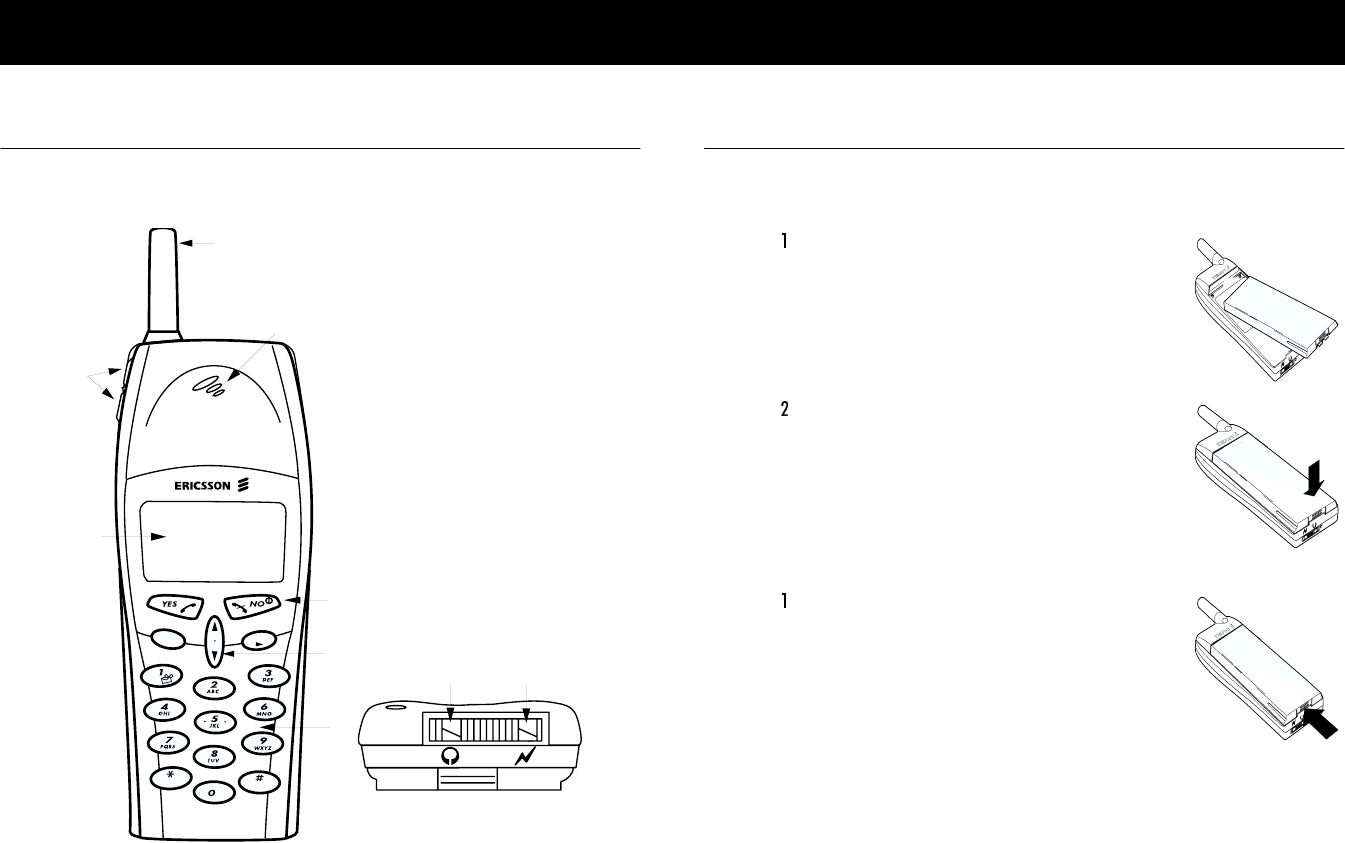
Draft - Not for Commercial Use - Ericsson Inc.
4Getting Started
Parts of Your Phone
For information on the key functionality, see “Voice Operation Key
Functions” on page 15.
Connecting and Removing Your Battery
Connecting Your Battery
Place the battery over the back of the phone.
The label on the battery should face down.
Insert the top portion of the battery into the
phone. The tab on the bottom of the battery
should be pointing toward the bottom of the
phone.
Press down until you hear a click. The battery is
now connected.
Removing Your Battery
Remove the battery by pushing in on the tab of
the battery with your thumb.
Getting Started
MENU
A1228c
a|A ,?!
System Port
Antenna
Earpiece
Power On/Off Key
Rocker Keys
Keypad
Display
Side Volume Keys
Headset Connector
Charging Port
➊
➋
➌
➍
➎
➏
➐
➑
➒
➊
➋
➌
➍
➎
➏
➐
➑➒
BACK
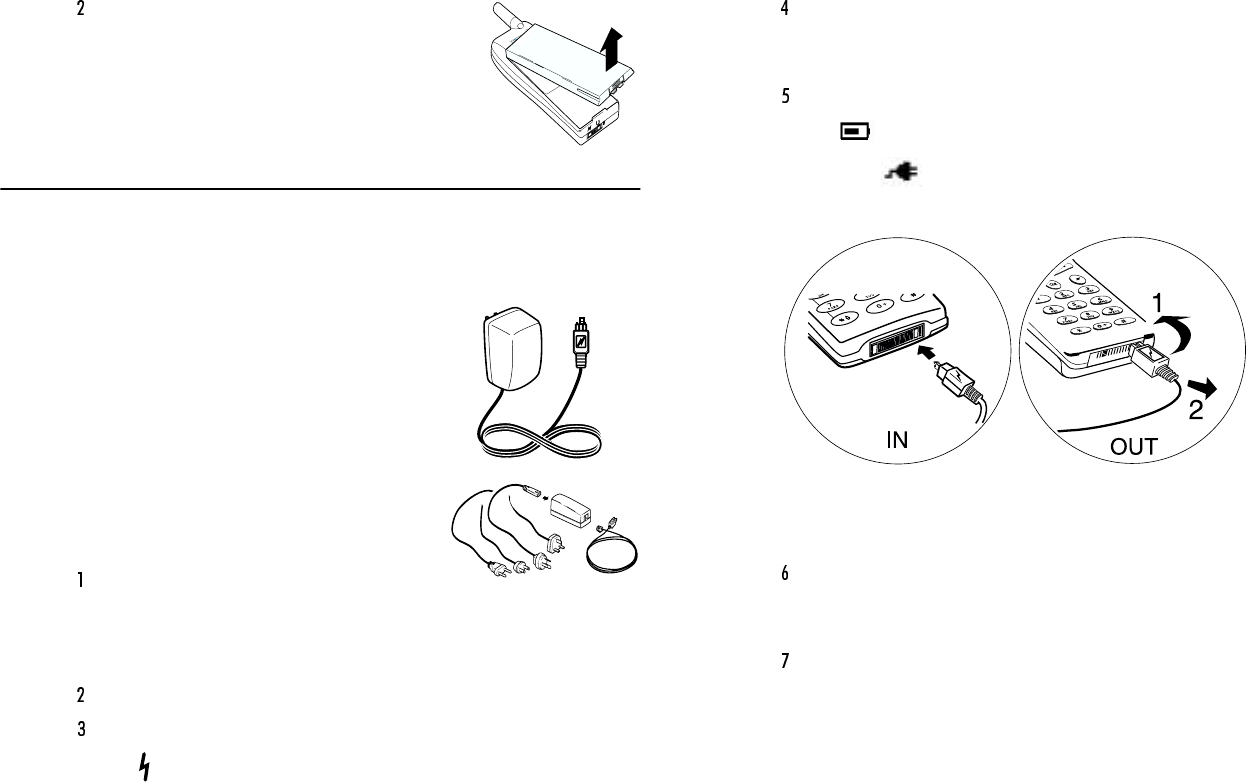
Draft - Not for Commercial Use - Ericsson Inc.
Getting Started 5
Lift the battery up and out of the battery cavity.
Charging Your Battery
Your Charger
Your phone was packaged with either a
rapid or travel charger. It is important that
you fully charge your battery before you
use your phone. Both chargers supply
power to charge your battery while the bat-
tery is attached to your phone. If your
phone is On, it can receive calls while using
either charger.
Note! NEVER attach the charger to a phone that
does not have a battery installed.
If you have a rapid charger, plug the
charger into a standard wall electrical
outlet. If you have a travel charger, connect the appropriate AC
power cord and phone charging cord to the travel charger.
Hold the phone with the display and keypad facing up.
Hold the small plug on the charger cord so the lightning bolt sym-
bol ( ) is up.
Align the small plug on the charger cord with the connector on
the bottom of your phone. The connector on the phone is above
the lightning bolt symbol.
Press the plug into the connector until the plug “snaps” into place.
The icon, which continuously fills and empties, is alternated
with the icon when the phone is powered on and is charg-
ing.
Note! Do not twist while inserting or removing the small plug on the
charger cord!
Continue charging the phone until the battery is fully charged.
When your phone is fully charged, the plug icon will remain sta-
ble.
To disconnect the charger, lift the plug connected to the phone
upwards and pull it out.
Charge-Only Mode
If your phone is off, attaching the charger will cause the phone to
activate in charge-only mode. When this mode is activated, an ani-
mated icon appears in the display. Your phone is now fast (rapid)
rapid
travel
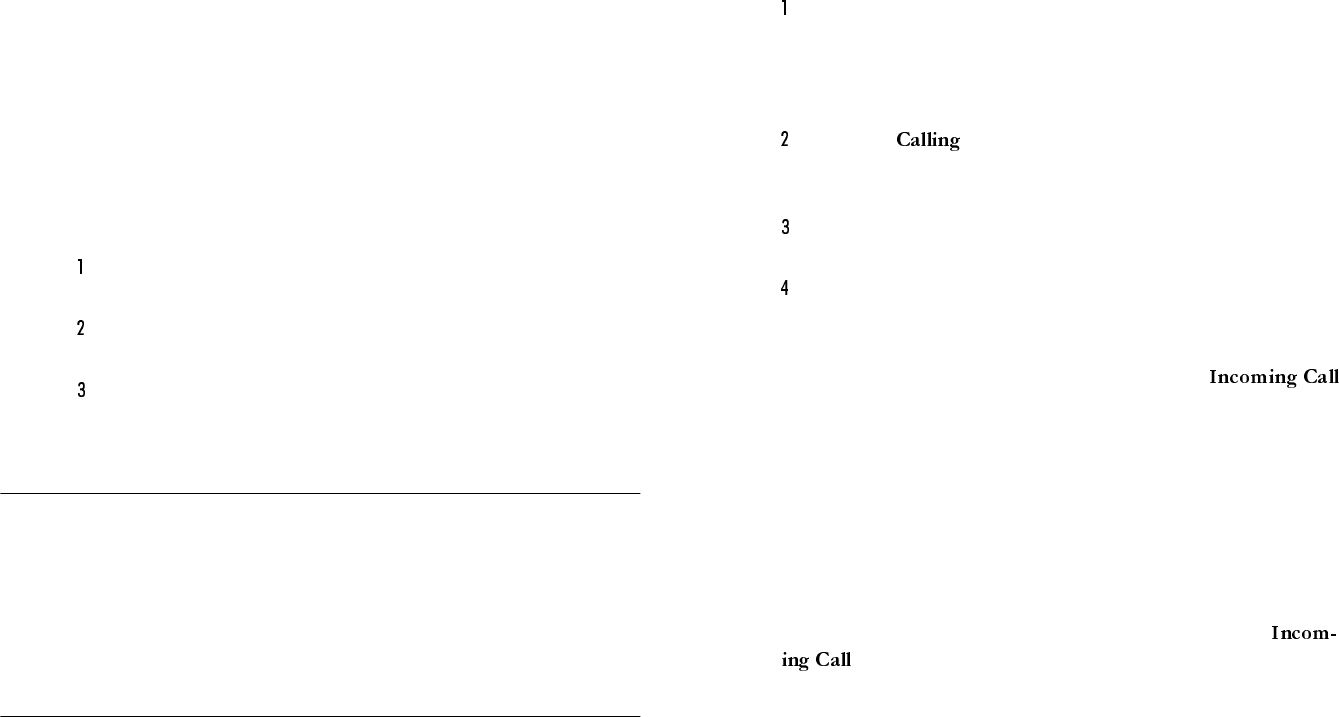
Draft - Not for Commercial Use - Ericsson Inc.
6Getting Started
charging the battery. When your phone is fully charged, the plug
icon will remain stable.
Note! You cannot make or receive calls when your phone is in charge-only
mode.
Slow Charging a Deeply Discharged Battery
The battery could become deeply discharged (for example, when the
battery is stored for a long period). As a result, the phone may not
immediately activate charge-only mode when the charger is con-
nected.
Attach the charger to the phone for several hours to slowly charge
(trickle charge) the battery.
After trickle charging the battery for several hours the phone
should activate the charge-only mode automatically.
Continue charging the phone until the battery is fully charged.
Turning Your Phone On and Off
Turn your phone On by pressing and holding NO until your phone
turns on. The phone will beep (unless silent mode is activated). Turn
your phone Off by pressing and holding NO until your phone turns
off. You must return to Standby mode to turn off your phone.
Making and Receiving Calls
See “Voice Calls” on page 16 for more information about making
and receiving calls.
Making Calls
Press the numeric keys to enter the phone number you want to
call. The number is shown in the display.
Note! You can press BACK to erase one or more digits in the display, or
press and hold BACK to erase all digits.
Press YES. , along with the number you are dialing, is
shown in the display while your phone accesses the wireless net-
work.
When the call is connected, a call timer is shown in your display.
The phone number that you dialed will remain on your screen.
To end the call, press NO.
Receiving Calls
When your phone receives a call, the ringer sounds,
appears in the display, and the display and keypad backlight illumi-
nate. You can temporarily silence the ringer by pressing NO or the
upper or lower side keys, and still answer the call by pressing YES. If
you have Caller Number Identification (Caller ID) service from your
service provider, the caller's phone number is shown in the display.
The caller’s name will also appear if the phone number is found in
your phonebook.
Answer the phone by pressing any key. For information on adjusting
your answering preferences, see “Auto Answer” on page 13.
is replaced by the call timer display once the call is
answered. End the call by pressing NO.

Draft - Not for Commercial Use - Ericsson Inc.
Getting Started 7
Operating Your Phone
You can use your Ericsson mobile phone in Voice, Browser, and
Wireless Modem Operation.
Voice Operation offers you all of the benefits of a traditional mobile
telephone, including placing and answering calls, and receiving voice
and text messages. When you see a screen similar to the one shown
below, your phone is ready to make and receive voice calls.
For more information, see “Voice Operation” on page 8.
Browser Operation allows you to browse the Internet and view web
content on your Ericsson mobile phone. See “Browser Operation”
on page 22. You can not receive voice calls while in Browser Mode.
Wireless Modem Operation allows you to use your phone as a
modem with your laptop or desktop computer to browse the Inter-
net, displaying web content on your computer screen. See “Wireless
Modem Operation” on page 30.

Draft - Not for Commercial Use - Ericsson Inc.
8Voice Operation
In Voice Operation, you can make and receive telephone calls; work
with your voice mail and messages; change your phone’s voice set-
tings; add, edit, or delete entries from your phonebook; and send
and receive text messages.
Your Display in Voice Operation
1 New Voice Mail Icon ( ) indicates the number of voice mail
messages that have not been heard. The icon appears only when
you have voice mail messages waiting. The number ( shown
above) indicates how many voice mail messages you have.
2 New Text Mail Icon ( ) indicates the number of text messages
that have not been read. The icon appears only when you have text
messages waiting. The number ( shown above) indicates how
many text messages you have.
3 Browser Alert ( ) indicates that there is new content in your
Inbox (for example, email or stock quotes).
4 Keypad Lock Icon ( ) or Phone Lock ( ) indicates that
pressing the keys has no effect. The keypad is locked to prevent
inadvertent key presses. Press MENU * to toggle Keypad Lock on
and off. Phone Lock restricts you from making calls, except emer-
gency calls. You must enter your PIN to enter the Phone Lock
submenu where you can turn Phone Lock off.
5 Current Time is displayed (if provided by the system).
6 Battery Icon ( ) shows the relative strength of your battery. A
full icon indicates a fully-charged battery. If the phone is con-
nected to external power and the battery is charging, the display
alternates between the battery icon, which will continuously fill
and empty, and the charging icon ( ).
7 Ringer Off ( ) Icon indicates that your phone will not make
ring sounds.
8 Phone Silent ( ) Icon indicates that your phone will not make
any sounds. Press MENU # to access Phone Silent.
9 Roaming Preferred icon indicates if you are roaming in a pre-
ferred network. If a preferred network is found, an will appear.
If the roaming network is not preferred, a lowercase will appear.
10 Analog/Digital Channel Indicator shows whether the phone is
operating in analog ( ) or digital ( ) mode. The No Service icon
Voice Operation
1234
5
67/8
910
11
12
13
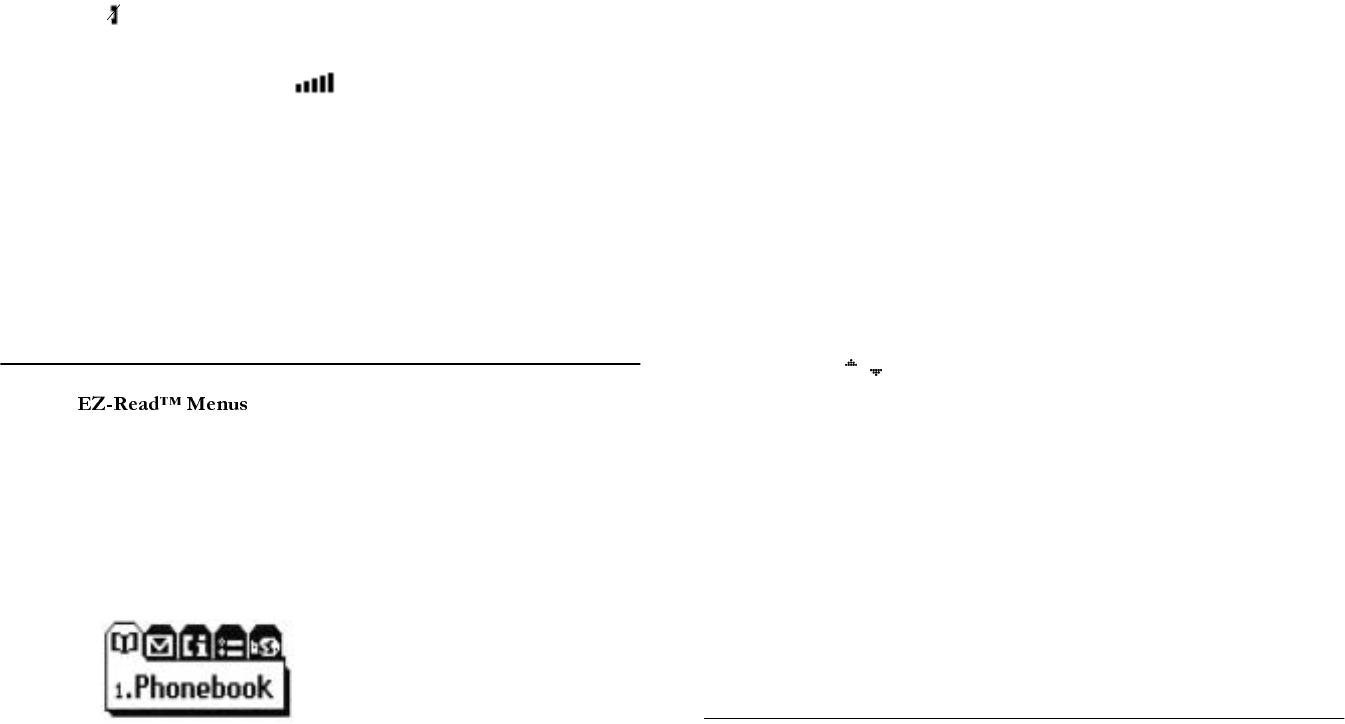
Draft - Not for Commercial Use - Ericsson Inc.
Voice Operation 9
( ) will appear in this location if an analog or digital channel is
not found.
11 Signal Strength Icon ( ) shows the relative signal strength
from the wireless system. More bars indicate a stronger signal
(maximum of five bars).
12 Current Date is displayed if provided by the system.
13 Banner indicates that the phone is in standby mode and is ready
for use. Your personal banner, or the network provided informa-
tion is displayed here.
Main Menu
make menu navigation and changing settings
simple. The tabbed menus clearly show the way. Use the rocker keys
to scroll through the menus and menu settings.
The main menu has five icons that display the top-level menu
options. The corresponding title of the selected option is displayed
below the menu tabs when highlighted. Each menu is represented by
an icon.
Option 1 is the PHONEBOOK menu (see “Phonebook Menu” on
page 9).
Option 2 is the MESSAGES menu (see “Messages Menu” on
page 10).
Option 3 is the CALL INFORMATION menu (see “Call Info Menu”
on page 11).
Option 4 is the SETTINGS menu (see “Settings Menu” on
page 12).
Option 5 is the BROWSER menu (see “Browser Menu” on
page 14).
Accessing Menus
Press MENU to access the main menu:
1 Press , to scroll through menu, functions in menus, and set-
tings in a function.
2 Press YES to choose the menu, function, or setting that is
selected.
3 Press NO to go back one level in the menu structure.
4 Press BACK to exit the menus completely.
Note! You can quickly access a menu by pressing MENU and the menu
number. For instance, to quickly access the SETTINGS menu, press
MENU 4.
Phonebook Menu
The PHONEBOOK menu contains the following choices for storing,
organizing, and recalling phone list information.

Draft - Not for Commercial Use - Ericsson Inc.
10 Voice Operation
List and Call
The submenu displays phonebook entries in their
location order. Select an entry or type in the position number and
press YES to call.
Add Entry
The submenu allows you to store a phone number and
an accompanying name in your phonebook.
List and Edit
The submenu allows you to change your phonebook
entries. These entries are also listed in their location order.
My Number
This submenu displays your phone number or phone numbers (if
your subscription includes Dual NAMs).
Find Entry
The submenu allows you to search for an entry number,
name, or location.
Scratchpad
If you need to make note of a phone number during a call, you can
use the Scratchpad. Once you end the call, you can call the number
from the Call List.
Auto Hyphenate
Auto-hyphen will automatically input dashes between phone num-
ber segments. For instance, if you enter 9194727908, the phone will
display 919-472-7908. You can turn Auto-hyphen On or Off.
Delete All Entries
The submenu allows you to erase every phone-
book entry. You will be prompted to enter your phone security PIN
to allow deletion. For more information, see “Security” on page 13.
Messages Menu
The MESSAGES menu contains choices for specifying and accessing
message services that may be available from your service provider (for
example, text messages and voice mail).
Voice Mail
The submenu allows you to enter and access your voice
mail access number if you have voice mail service from your service
provider. A number and the voice message icon ( ) appear in the
Standby screen to indicate the number of new unread voice mes-
sages. The maximum number of new voice mail messages that can be
displayed is 99. The submenus are and
Message Inbox
The submenu allows you to read your new text messages. A
number and the text message icon ( ) appear in the Standby
Screen to indicate the number of unread text messages. The maxi-
mum number of new text messages that your phone can store is 30.
You have the options to reply, or delete the message.
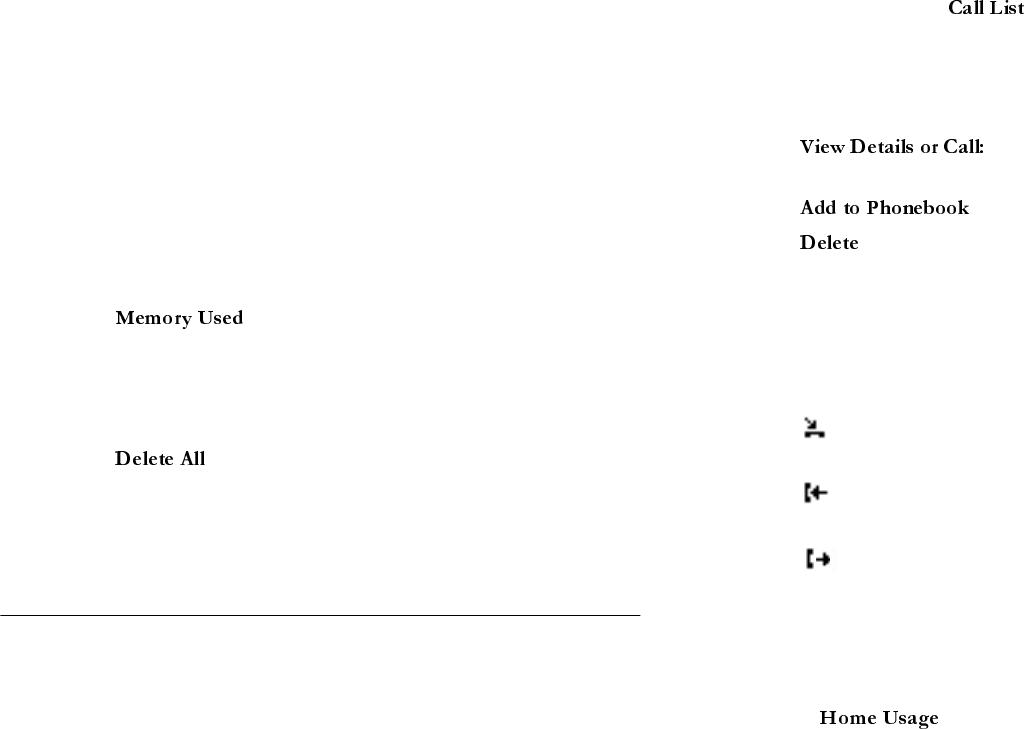
Draft - Not for Commercial Use - Ericsson Inc.
Voice Operation 11
Message Outbox
The
Sent Box
submenu stores successfully sent and unsuccessfully
sent SMS messages. You can delete, resend, and forward the mes-
sages.
Send Message
The
Send Message
submenu is used to create new text messages or
send canned (predefined) messages. An example of a canned message
is “Okay I got it”. The submenus available are: Create New, Use
Canned Msg, and Send a Page.
Memory Used
The submenu displays the percentage of the phone’s
memory that is occupied and the percentage that is available for stor-
age.
Delete All
The submenu allows you to erase all of your unread and
read text messages. Submenus include: Message Inbox and Message
Outbox.
Call Info Menu
The CALL INFO menu allows you to view information and establish
dialing and answering preferences for your phone (some selections
available in this menu are dependent on your service provider). It
also enables you to view and edit system options and call statistics.
Call List
Press YES from the submenu to view the last 45 received,
missed, sent calls, or numbers entered in the scratchpad.
From this list you may view details, call, add the number to your
phonebook, or delete the number
• Press YES. Press YES again to call the
number.
•: Press, and briefly hold, YES.
•: Press BACK.
Icons
One of following icons will appear next to each number in the Call
List.
Home Usage
The displays the number of home calls made and
received and the accumulated time since last resetting the home call
counters. Press YES to reset home usage.
Missed Call
Answered Call
Outgoing Call
Note! Entries without an icon are scratchpad entries.
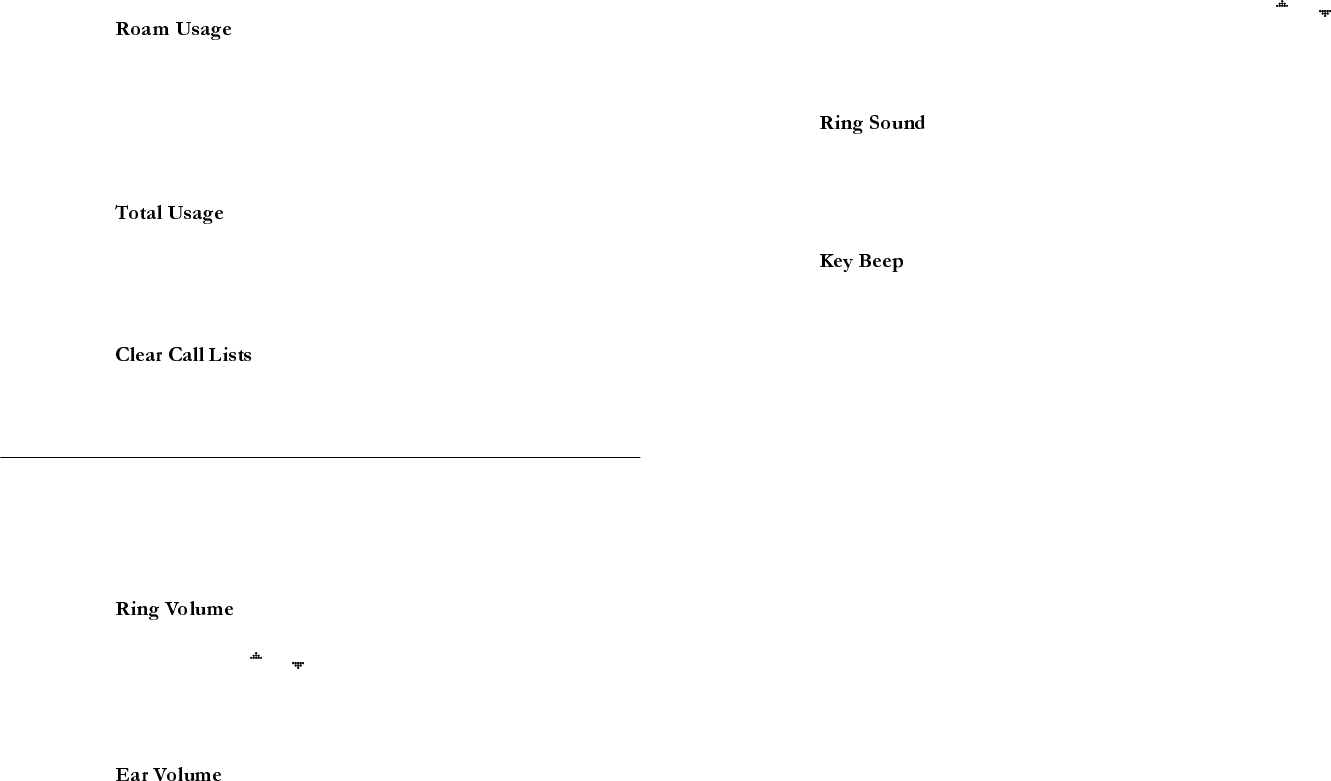
Draft - Not for Commercial Use - Ericsson Inc.
12 Voice Operation
Roam Usage
The displays the number of roaming calls made and
received and the accumulated time since last resetting the roam call
counters. Press YES to reset roam usage.
Total Usage
The submenu shows you the total number of calls and
the total hours and minutes that have been used for the lifetime of
the phone.
Clear Call Lists
The submenu allows you to erase all call list entries.
Settings Menu
Sounds
Ring Volume
The submenu allows you to set the level of the ring
volume. The volumes range from Off to High. You can make your
selection by pressing or . Then press YES to confirm your selec-
tion.
Ear Volume
The submenu allows you to adjust the volume of the
earpiece using the menu setting. You can also adjust the volume dur-
ing a call by using the side volume keys. The volumes range from
Very Low to High. You can make your selection by pressing or .
Then press YES to confirm your selection.
Ring Sound
The submenu allows you to choose the type of sound
or melody for the ringer. Each sound or melody is demonstrated as
you scroll through the selections. There are 25 ring sounds.
Key Beep Volume
The submenu allows you to choose the sound made when
you press keys. The four options for Key Beep are Off, Low,
Medium, or High.
Phone Silent
You can set all of your phone’s sounds to be silent. Options include
On and Off.
Minute Minder
Minute Minder notifies you when each minute passes while you are
engaged in a call. Settings are On and Off.
My Number
This submenu displays your phone number or phone numbers (if
your subscription includes Dual NAMs).
Keypad Lock
The Keypad Lock submenu is used to protect your keypad from
unintended key presses (for instance, if you keep your phone in your
pocket or pocketbook). Press MENU * to lock the keypad. The key-
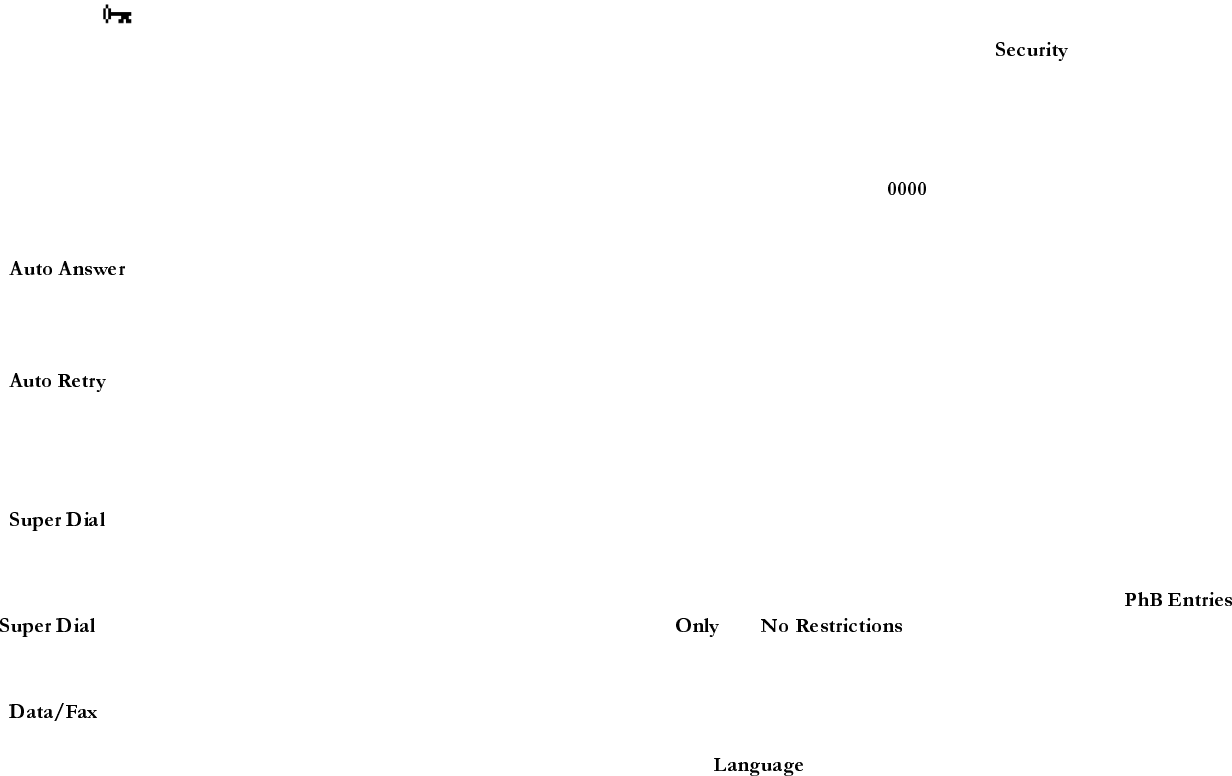
Draft - Not for Commercial Use - Ericsson Inc.
Voice Operation 13
pad lock icon ( ) will appear in the display. To unlock the key-
pad, press two-key combination to unlock.
If a call is received while keypad lock is on, the keypad lock will be
be temporarily disabled and the user can answer the call. When the
call ends, the keypad lock will automatically be enabled.
Call Options
Auto Answer
The submenu options are On and Off. When set to
On, auto answer will answer six seconds after a call is received.
AutoRetry
The submenu will prompt the phone to redial a number
if the system was busy or no network is found on the initial attempt.
The phone will redial up to five times. Options include On and Off.
Super Dial
The submenu allows you to dial a phone number stored
in phonebook positions 1 through 99 by pressing and holding the
numeric key corresponding to the phonebook position (you must
press and hold the 2nd digit for 2-digit positions). The two options
for are On and Off. Position 1 is reserved for voice mail.
Data/Fax
The submenu allows you to set your phone to send and
receive only data or only fax calls. Settings include: Off, Next Call
Fax, Fax On, Next Call Data, and Data On.
Note! The Off setting is active until you choose a different setting. Fax On
and Data On apply until you power off your phone.
Security
Note! You must enter your PIN to access the submenu.
Change PIN
Your phone has a PIN that you must enter to gain access to certain
functions, such as call restrictions and calling card numbers. The fac-
tory-programmed code is . You can change this code to provide
maximum security for your phone by using the Phone Security sub-
menu. If you forget your PIN, contact your service provider for assis-
tance.
Phone Lock
Phone Lock restricts you from making calls (except emergency calls),
entering menus, and making super dial calls (including voice mail),
each time you turn the phone on. To unlock the phone, enter your
PIN. You will be prompted to enter your PIN to enter the
Phone
Lock
submenu. Options include Phone Lock Off, Power On, and
Phone Lock On.
Restrict Calls
This feature will restrict outgoing calls to phone numbers that are
stored in phonebook locations 1-200. Options include
and . When this feature is set to Phonebook
only (PhB Entries Only), the phone will not allow new entries to be
saved to, or erased from, the phonebook.
Language
The submenu allows you to select the language used in
the phone display. The languages vary between markets. Your mobile
phone supports English, French, Spanish, and Portuguese.

Draft - Not for Commercial Use - Ericsson Inc.
14 Voice Operation
Display
The submenu is used to change the Backlight, Banner, and
Time display of your phone.
Backlight
Use the submenu to set the display and keypad backlight-
ing to stay Off or to automatically turn On for 20 seconds when a
call is received or a key is pressed. The two settings for are
Auto and Always Off.
Change Banner
Use the submenu to alter the information that is
displayed when your phone is in standby. You can enter whatever
message you would like to see (up to one line of text).
Time Format
The time in your phone’s display will always be current because it is
updated by your network. You have the option to set the time to am/
pm or 24-hour format.
System Options
The submenu allows you to select what system you
wish to use. There are three options in the sub-
menu: Auto System, System Select, and Next Call Analog.
Auto System
Auto System options include On and Off.
System Select
If you select System Select, you can choose from Standard, A Only, B
Only, or Home Only.
Next Call Analog
Next Call Analog options are No and Yes.
Browser Menu
See “Browser Operation” on page 22 for more information.
Launch Browser
This submenu allows you to activate Browser mode.
Text Size
You can choose how large the text appears in your display. Options
include Normal (7 point) and Large (8 point).
Note! This setting only affects the text size in Browser mode.
Alert Sound
The phone will sound when you receive new content in your Inbox
(for example, stock quotes or email). Options include On and Off.
Network
This submenu allows you to view and modify networks settings. You
will be prompted to enter your PIN to make any modifications. This
is typically not necessary so you should contact your service provider
before making any network changes.

Draft - Not for Commercial Use - Ericsson Inc.
Voice Operation 15
Voice Operation Display Messages
The following are common display messages on your mobile phone:
Note! Icons appearing on your phone’s display differ in Voice, Browser, and
Wireless Modem Operation.
Voice Operation Key Functions
.
____
Dec 31 12:12p
m
NO
•Press and hold to turn phone ON and OFF.
•Press to end a call.
•Press to go back one level.
•Press during an incoming call to temporarily mute
ringer.
•Press to clear current display.
YES
•Press to answer incoming call
•Press to place a call after entering a phone number.
•Press to dial last number dialed.
•Select a setting or menu.
BACK
•Delete a digit.
•Press and briefly hold to delete all digits from screen.
•Press and briefly hold during a call to mute micro-
phone.
•Exit menu to standby mode.
•Delete a character in text entry. Press and briefly hold
to delete all characters.
BACK
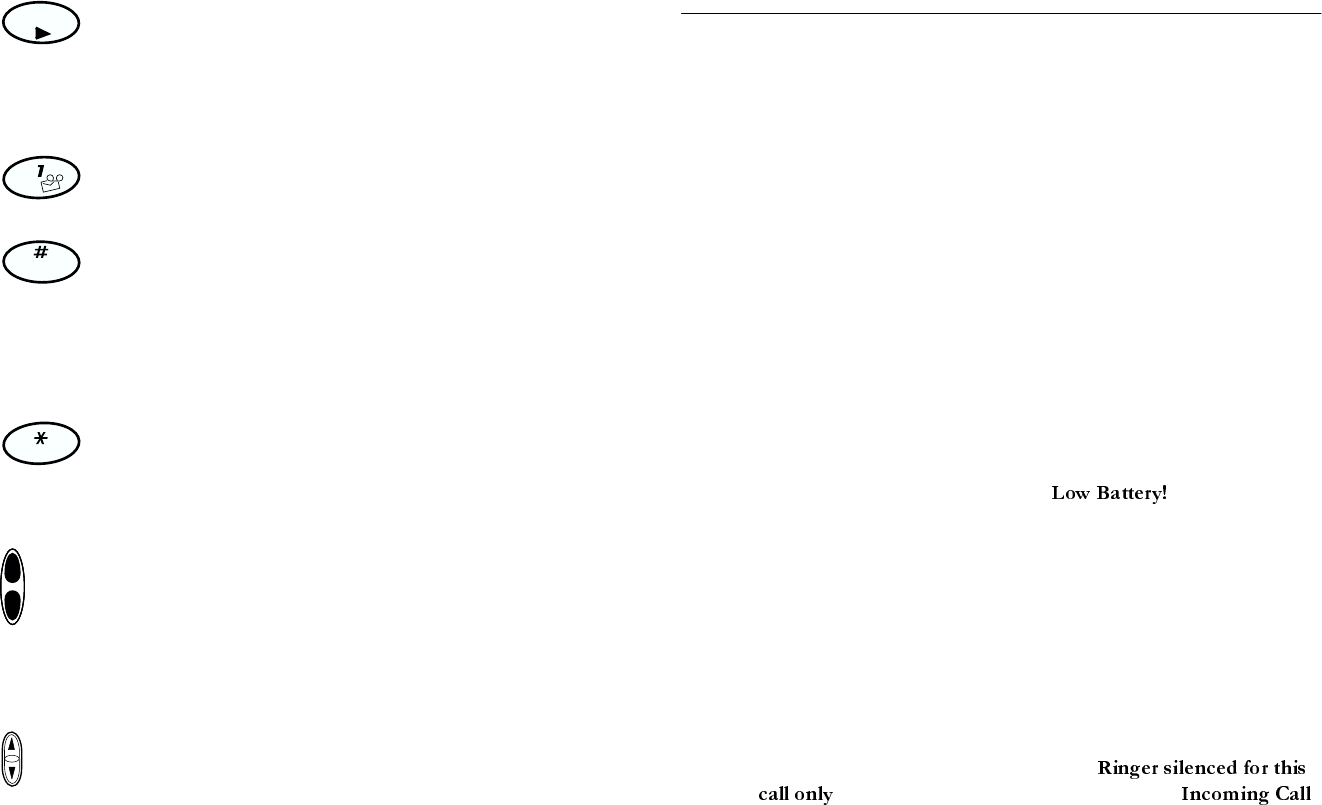
Draft - Not for Commercial Use - Ericsson Inc.
16 Voice Operation
Voice Calls
For information on making and receiving calls, see “Making and
Receiving Calls” on page 6.
Redialing the Last Number You Called
Your telephone stores the last number you dialed. Press YES to dial
this number.
Adjusting Ear Volume During a Call
To increase the ear volume during a call, press the upper key on the
side of your phone.
To decrease the ear volume during a call, press the lower key on the
side of your phone.
Low Battery Power Alert
The low battery alert sounds when your battery is reaching its lowest
operational power level. The words will appear in the
display. When this happens, connect your phone to your Ericsson
charger to recharge your battery or replace it with a fully charged
battery. If you leave your phone turned on, the phone discharges the
battery and then automatically turns off. Charge the battery within
24 hours after a complete discharge so that the battery can charge to
full capacity.
Temporarily Muting the Ring Tone
To temporarily mute the ring tone without answering the call, press
NO or the up or down side volume keys.
briefly appears in the display, followed by .
MENU
•Press to enter menus.
•Press from the main menu to tab through the menus.
•Press MENU anywhere in the menu system to return
to the main menu.
1/VOICE MAIL
•Press and hold to call voice mail.
#/POUND
•Press and hold to create a Stop character in a dial
string
•Press MENU # for Silent Mode.
•Press to easily access punctuation characters in text
entry.
*/STAR
•Press and hold to create a Pause in a dial string.
•Press MENU * for Keypad Lock.
•Press to toggle lowercase and uppercase in text entry.
SIDE VOLUME KEYS
•Press up or down to adjust earpiece volume during a
call.
•Press to illuminate the backlight.
•Press either key to temporarily mute the ring signal of
the incoming call.
ROCKER KEYS
•Press to move throughout menus and submenus.
•Press to scroll through phonebook entries and text
messages.
MENU
,?!
a|A
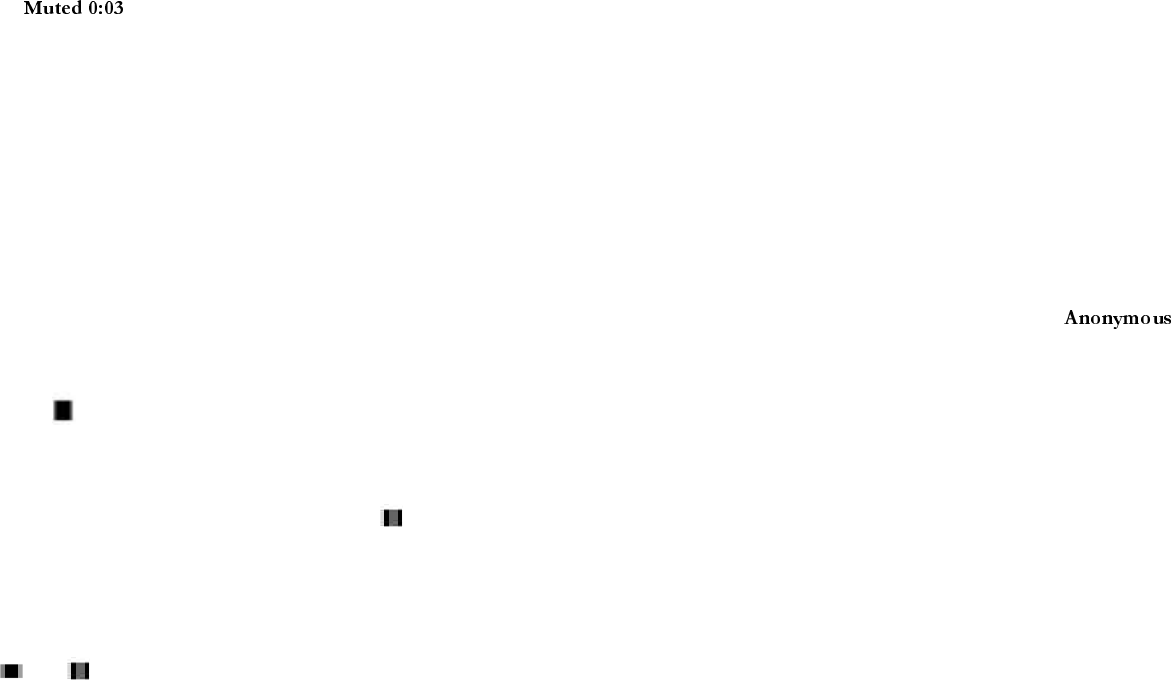
Draft - Not for Commercial Use - Ericsson Inc.
Voice Operation 17
You can still answer the call by pressing YES. For information on
adjusting your answering preferences, see “Auto Answer” on page 13.
Muting the Microphone During a Call
To mute the microphone during a call, press and briefly hold the
BACK key. appears in the display when the call is
muted. Use the BACK key to toggle mute.
Note! You cannot mute the microphone during an emergency call.
Stop and Pause Dialing
Stop and pause dialing lets you enter individual numbers or groups
of numbers with stops and pauses between each group of numbers.
This feature is useful when you need to dial a phone number and
then another number, such as an access number for an answering
machine or voice mail system or to enter a calling card number and
verification code.
A stop causes the phone to stop transmitting numbers until you
press YES. You can enter a stop in a series of digits by pressing and
holding # until is shown in the display.
A pause temporarily suspends transmitting numbers for approxi-
mately two seconds before sending the next series. You can enter a
pause in a series of digits by pressing and holding * until is shown
in the display. For example, if your office has a voice mail system that
requires you to dial a phone number, followed by your extension,
followed by an access code.
For example, you could enter the following:
555-1111 2222 33333.
When you press YES, your phone dials the number and then stops
transmitting tones. When your voice mail system asks for your
extension you would press YES to transmit your extension. The
access code is sent after the pause. If the timing in your voice mail
system does not allow for pauses, you can enter a stop instead of the
pause, or use multiple pauses.
You can also store groups of numbers which can include stops and
pauses in a phonebook location. You can then dial the numbers by
entering the phonebook location and pressing YES.
Caller Identification
If your service provider has Caller Number Identification (Caller ID)
service, your phone shows the phone number of an incoming call in
the display. If the number is one that you have stored in your phone-
book with a name, the name is shown when your phone rings. If the
Caller ID information is not available, a message such as Unavailable
or Restricted may be shown in the display. The word
may be shown if the Caller ID is restricted by the service provider or
by the caller.
Call Waiting
If you have call waiting service from your service provider, press YES
to answer a call when you receive the call waiting signal. You can
switch between the two calls by pressing YES.
Note! Do not press NO until you are ready to end both calls.
Call Forwarding
Note! Call Forwarding may be offered by your service provider. To forward
a call, press *, plus a numerical code (provider by your service pro-
vider), then enter the forwarding number, and press YES. The
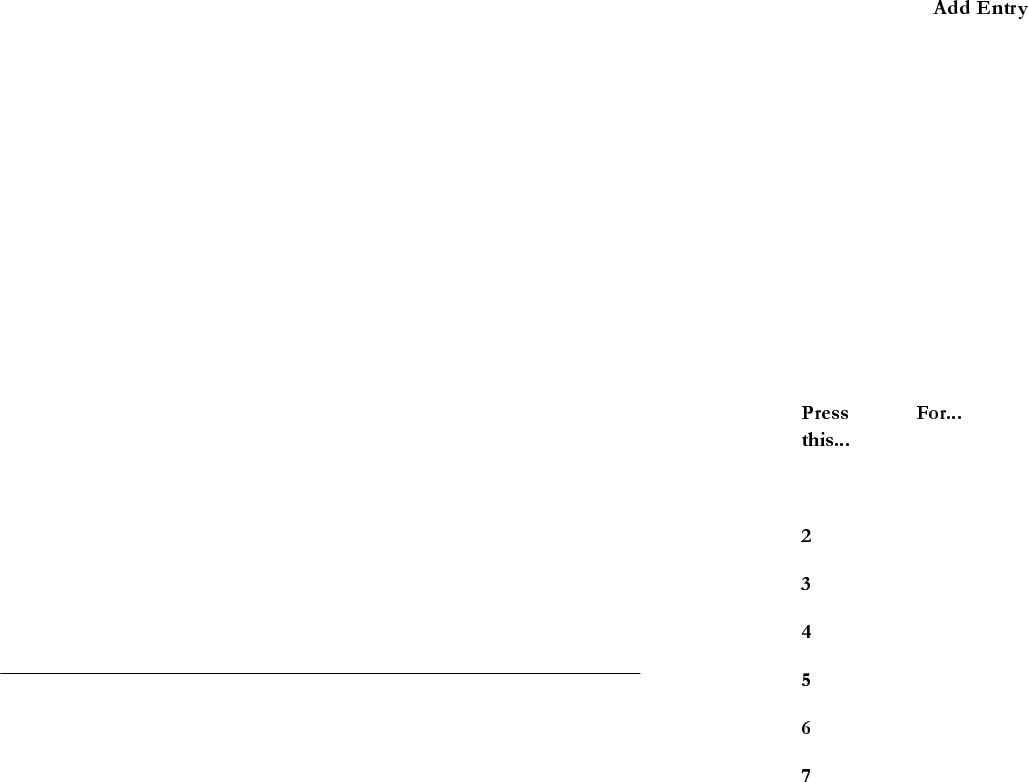
Draft - Not for Commercial Use - Ericsson Inc.
18 Voice Operation
phone will beep and display a confirmation message that you have
forwarded your calls. Refer to your service provider for more details.
Three-Way Calling
Three-way calling is offered by some service providers and allows
three parties to participate in the same phone conversation. To set up
a three-way call:
1 Dial the first person.
2 Press YES to put the first call on hold.
3 Dial the second person and press YES.
4 When the second person picks up, press YES again to join all
three calls.
Note! If one of the other people hangs up, you will remain connected with
the other person. The three-way call will be disconnected when you
hang up.
International Calls
Note! If allowed by your service provider, you can place international calls
with your phone just as you would from any other phone. If you
have difficulty completing international calls, check with your ser-
vice provider for information.
Using Your Phonebook
Creating Phonebook Entries
You can add entries to your phonebook by doing the following:
1 Press MENU from the Standby screen to access the main menu.
2 Press 1 to display the PHONEBOOK menu.
3 Press 2 to select .
4 Enter the phone number and press YES.
5 Enter the person’s name and press YES.
6 Press YES to select the first available position or enter another
position number. Press and hold YES to securely store the num-
ber (this will prevent you from accidentally overwriting the num-
ber with another).
Entering Letters and Symbols
Press the appropriate key, 0-9, #, or * repeatedly, in quick succes-
sion, until the desired letter, character, or digit appears in the display.
For example, to enter an
A
, press the numeric key 2 once. To enter a
B
, press the numeric key 2 twice.
1Space 1
A B C 2 À Á Â Ã Ç
D E F 3 È É Ê Ë
G H I 4 Í Î Ï
J K L 5
M N O 6 Ñ Ó Ô Õ
P Q R S 7
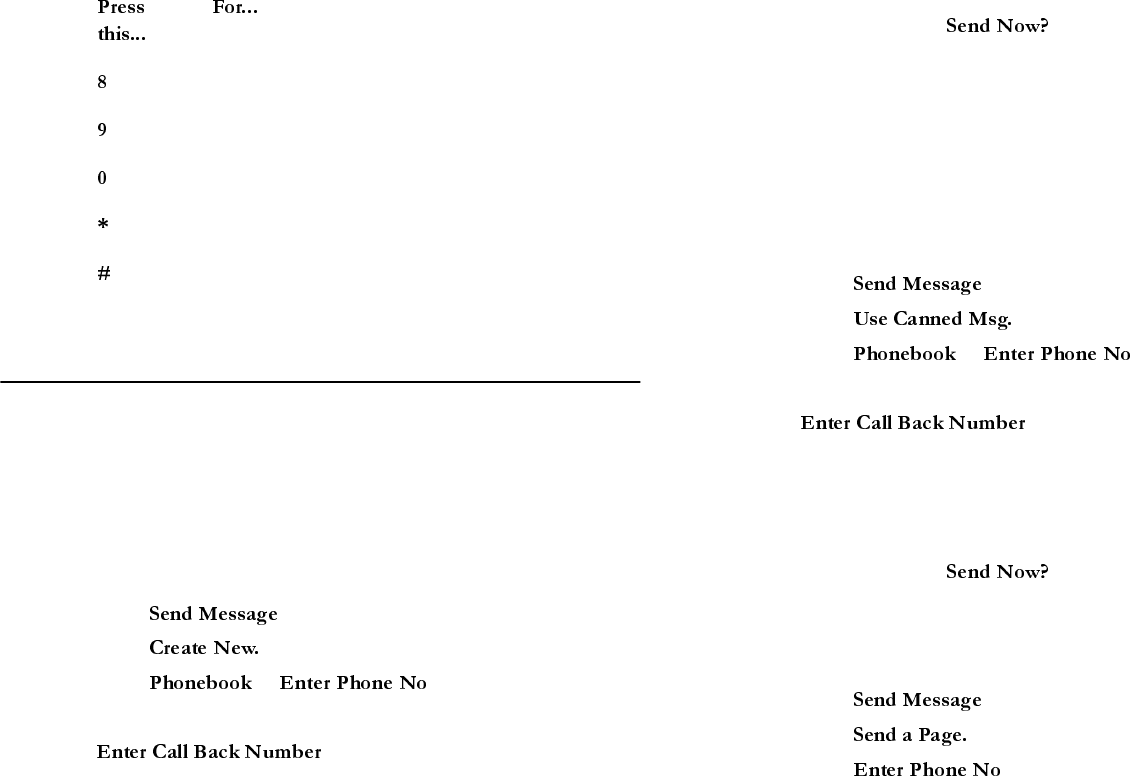
Draft - Not for Commercial Use - Ericsson Inc.
Voice Operation 19
Short Message Service (SMS)
Sending Text Messages
New Messages
This feature allows you to enter a text message up to 239 characters.
For more information on entering text messages, see “Entering Let-
ters and Symbols” on page 18.
1 Select from the MESSAGES menu.
2 Select
3 Select or .
4 Enter the recipient’s phone number and press YES.
5 will appear. Press NO to proceed or
press YES to enter a call back number. Enter a new number or
press YES to send your phone number (your phone number will
be the default).
6 Enter the text message.
7 Press YES to the prompt. Press YES to send.
Canned Messages
Canned messages are predefined messages that are already stored in
your phone. These are some examples of canned messages:
•OK I got it.
•Please call me back.
•See you later.
1 Select from the MESSAGES menu.
2 Select
3 Select or .
4 Enter the recipient’s phone number and press YES.
5 will appear. Press NO to proceed or
press YES to enter a call back number. Enter a new number or
press YES to send your phone number (your phone number will
be the default).
6 Select the canned message that you wish to use.
7 Press YES to the prompt. Press YES to send.
Pages
You can send a numeric page without entering any text.
1 Select from the MESSAGES menu.
2 Select
3 Select .
4 Enter the recipient’s phone number.
T U V 8 Ù Ú Û Ü
W X Y Z 9
0
Toggles between upper and lowercase letters (a/A).
, . ? - ( ) ' \ " ! ; : # @ & $ % + - * / | = < > _
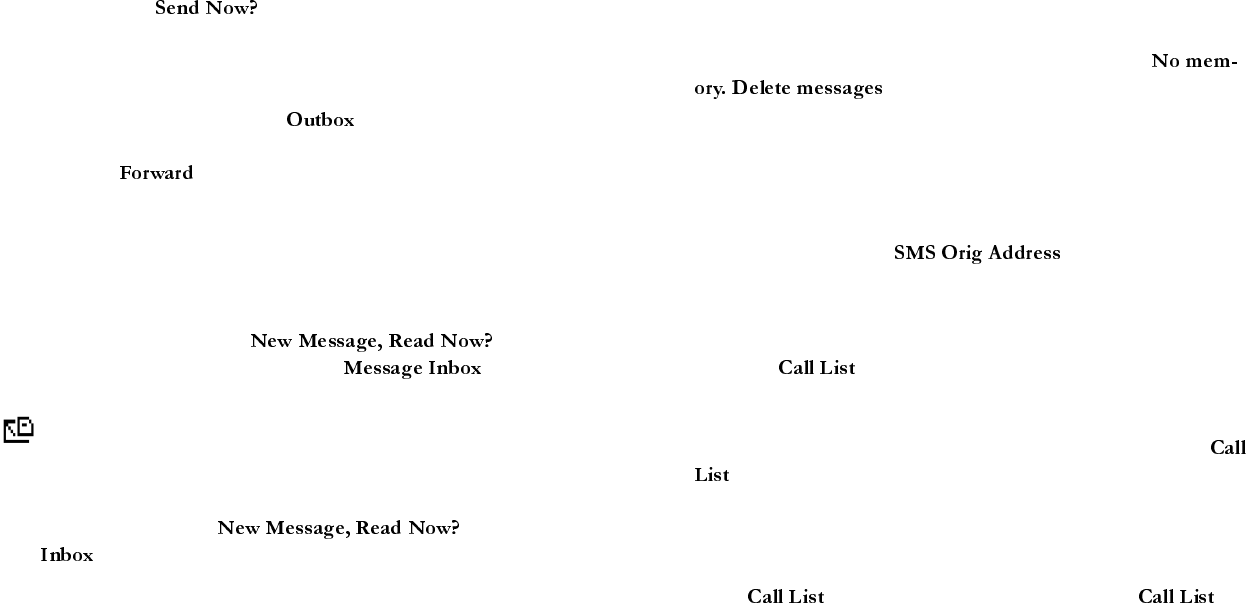
Draft - Not for Commercial Use - Ericsson Inc.
20 Voice Operation
5 Press YES to the prompt. Press YES to send.
Forwarding or Resending Messages
If your message is not successfully sent, you can resend it. Unsuccess-
fully sent messages are stored in the . You can also forward
text messages that you originated. To forward or resend, select the
message. Select . You will be prompted to reenter the recip-
ient’s phone number (or you can enter a new number). Press YES to
send the message.
Reading Text Messages
When you receive a text message, you will hear a beep (unless Silent
Mode is activated) and the text will
appear. The message will be stored in your if you
do not read it when it arrives. An icon present on the standby screen
( )indicates new text messages. The number of new messages
will be presented next to the icon. The phone will hold up to 30 new
messages.
1 Press YES when you see or select
the from the MESSAGES menu.
2 Select a message to read.
Note! Messages are listed first by priority and then by time. The sender’s
name will appear if the sender’s name is found in your phone book.
If available, the phone number will appear. If not, the first few lines
of the message will appear.
3 After reading the message, you have the option to view the Call
List, Erase, or Reply. The message will remain in your Inbox until
your mailbox becomes full. Messages in the Inbox will be over-
written beginning with the oldest.
Note! When the mailbox is full, messages that have been read or sent will
be overwritten. Unread and unsent messages will not be overwritten.
If the mailbox is filled with unread or unsent messages,
will appear, when a new message arrives,
prompting you to clean the mailbox so a new message can be stored.
Replying
After reading an SMS message, you have the option to reply to the
sender. A cursor will appear allowing you to modify the message
before sending it. Select to reply to the original
sender.
SMS Call List
The SMS stores phone numbers obtained from incoming
SMS messages. These numbers may include the sender’s phone
number or a number written into the text message (embedded num-
bers). You have the option to edit the phone number from the
prior to initiating a call.
If you receive a message such as, “Hello John. Sorry I missed you.
Please call me at 919-472-7908 or 1-800-374-2776.” The two num-
bers listed in the message, as well as the sender’s number, will appear
in the . After you have read the message, the will
appear giving you the option to call the sender or one of the num-
bers written in the message.
In the sample message above, 919-472-7908 and 1-800-374-2776
are embedded numbers. If you send text messages with embedded
numbers, you should use one of these formats:
•9194727908
•“9194727908”

Draft - Not for Commercial Use - Ericsson Inc.
Voice Operation 21
•919-472-7908
•1-800-ERICSSON
Deleting Messages
You may wish to delete all messages from your phone. This option is
available in the MESSAGES menu. You will be prompted to enter your
PIN and then select whether to delete the or
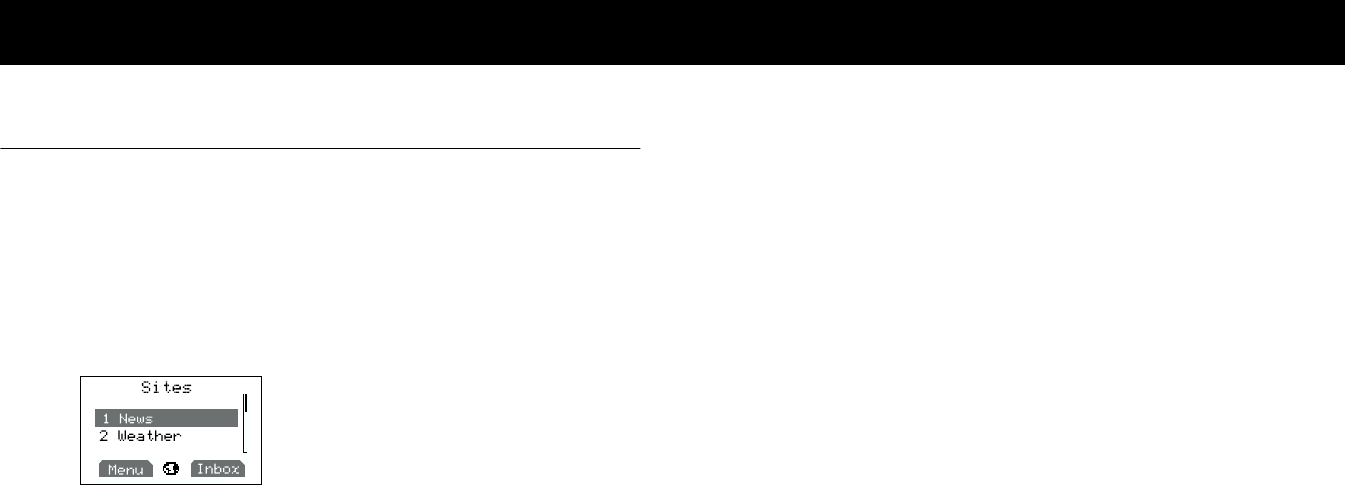
Draft - Not for Commercial Use - Ericsson Inc.
22 Browser Operation
s
Browser Operation
Your phone includes a built-in browser that allows you to access
Internet content designed especially for mobile phones. This content
typically includes Email, Calendar, and Contacts.
While in Browser Operation, your phone displays information (con-
tent) retrieved from the Internet via the digital network. The content
available to your phone is determined by your content provider.
Email
Your content provider can enable email as an application for use with
your browser. If this feature is enabled, you can send to and receive
email from anyone with an Internet email address.
Calendar
Your content provider can enable the calendar application for use
with your browser. If this feature is enabled, you can set meeting
reminders as Alerts and also set future appointments.
Contact List
Your content provider can enable the contact list for use with your
browser. If this feature is enabled, you can look up addresses to call,
view, or email.
Using the Phonebook
You can download a phonebook using the browser and store it in
your phone. If you download a phonebook using the browser, it will
overwrite your existing phonebook entries.
Making Calls
This submenu allows you to place calls from within the browser (the
browser session will be suspended). After completing the call, the
phone will resume the browser session and return to the page that
was active before making the call.
The World
You have access to the world from your Ericsson mobile phone in
Browser Operation. This includes maps, games, stock quotes,
weather, and a host of other applications.
Browser Operation
......................
.
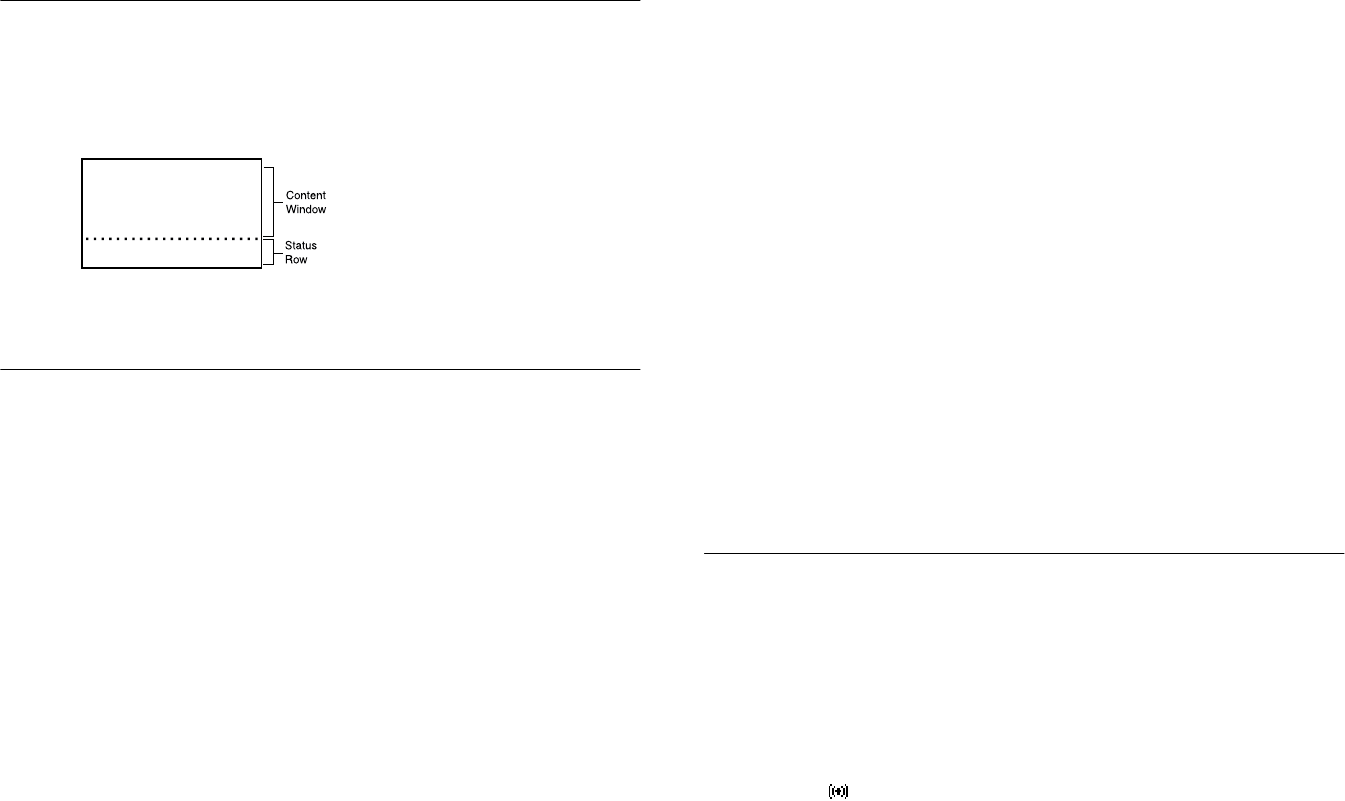
Draft - Not for Commercial Use - Ericsson Inc.
Browser Operation 23
Your Phone’s Display in Browser Operation
The display in Browser Operation is separated into two areas, the
content window and the status row. The content window is the area
of the screen above the dotted line and the status row is the area
below the dotted line.
Accessing the Browser Menu
The Browser Menu can be accessed through the menu key. The fol-
lowing submenus will appear once you have entered the Browser
menu.
Launch Browser
By selecting Launch Browser, you can access the home page that is
set by your service provider.
Each time you launch the browser, the last accessed page will appear.
The next time you power on and launch the browser, your service
provider’s home page will appear. Press MENU to access the BROWSER
menu, then choose Exit to return to standby.
Text Size
You can choose between two different text sizes. The Normal Size (7-
point type) will display five lines of text, including the status rows.
The Large Size (8-point type) will display four lines, including the
status row.
Alert Sound
You can specify if you want sound associated with your browser alert
mechanism. The two options for Alert Sound are On and Off.
Network
You can view or modify your Wireless Application Protocol (WAP)
gateway settings. You should not alter your gateway settings unless
you are instructed to do so by your service provider. You will be
prompted to enter your PIN. Contact your service provider for your
PIN.
Setting Linger Time
You can set the amount of time allowed to access a network to one of
three options: 30 seconds, 1 minute, 90 seconds, or 2 minutes.
Longer linger time will increase airtime during periods of inactivity.
Working within the Browser
The Browser Alert
While Browsing
When you have new content in your inbox, your phone will notify
you of its priority.
No and Low Priority
- Backlight will come on and the browser alert
icon will appear.
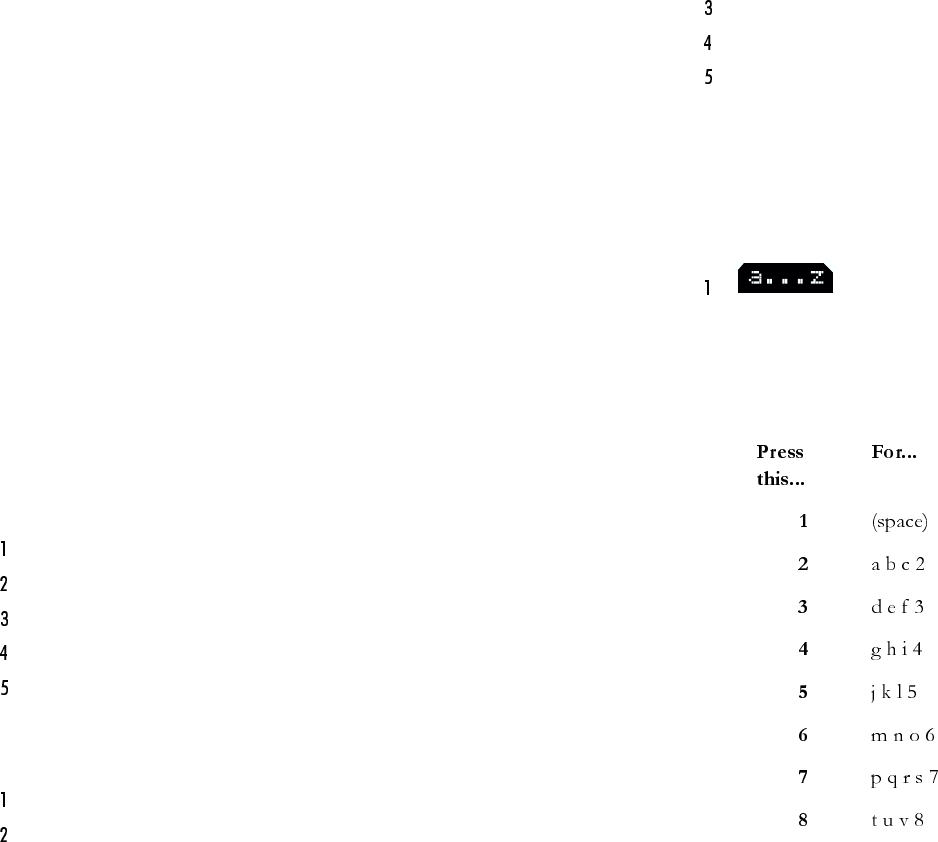
Draft - Not for Commercial Use - Ericsson Inc.
24 Browser Operation
Medium Priority
- The backlight and icon will appear, and an alert
will sound (if set to on).
High Priority -
The backlight and icon will appear, an alert will
sound, and a pop-up message will indicate that an alert has been
received.
While in Voice Mode
An alert received in voice mode is similar to receiving an SMS or
voice mail alert. The browser alert icon will be displayed in the
standby screen and will remain until you acknowledge the alert.
Gateway Settings
The Gateway address is the IP address of the gateway server to which
your phone will connect. The server stores web content for your
phone to access, including your Home Page. Your phone can store
three independent Gateway Addresses, allowing you to easily switch
between gateways.
Setting Gateway Addresses
Select the BROWSER menu.
Choose Network.
Choose
Modify
. You will be required to enter your PIN.
Choose Gateway.
Enter the IP Address. The dots are automatically added. Leading
zeroes are necessary where appropriate.
Selecting an Active Gateway
Select the BROWSER menu.
Choose Network.
Choose
Modify
. You will be required to enter your PIN.
Select Active Gateway.
Select the Gateway you wish to activate.
Text Entry
You can enter characters in four different modes. The active format
is displayed in the right soft key position. You can change the format
in which characters are entered by pressing the right soft key.
mode allows you to enter alphabetic text.
Press the appropriate key, 0-9, or # repeatedly until the desired let-
ter, character, or digit appears in the display. For example, to enter
an a, press the numeric key 2 once. To enter a b, press the numeric
key 2 twice.
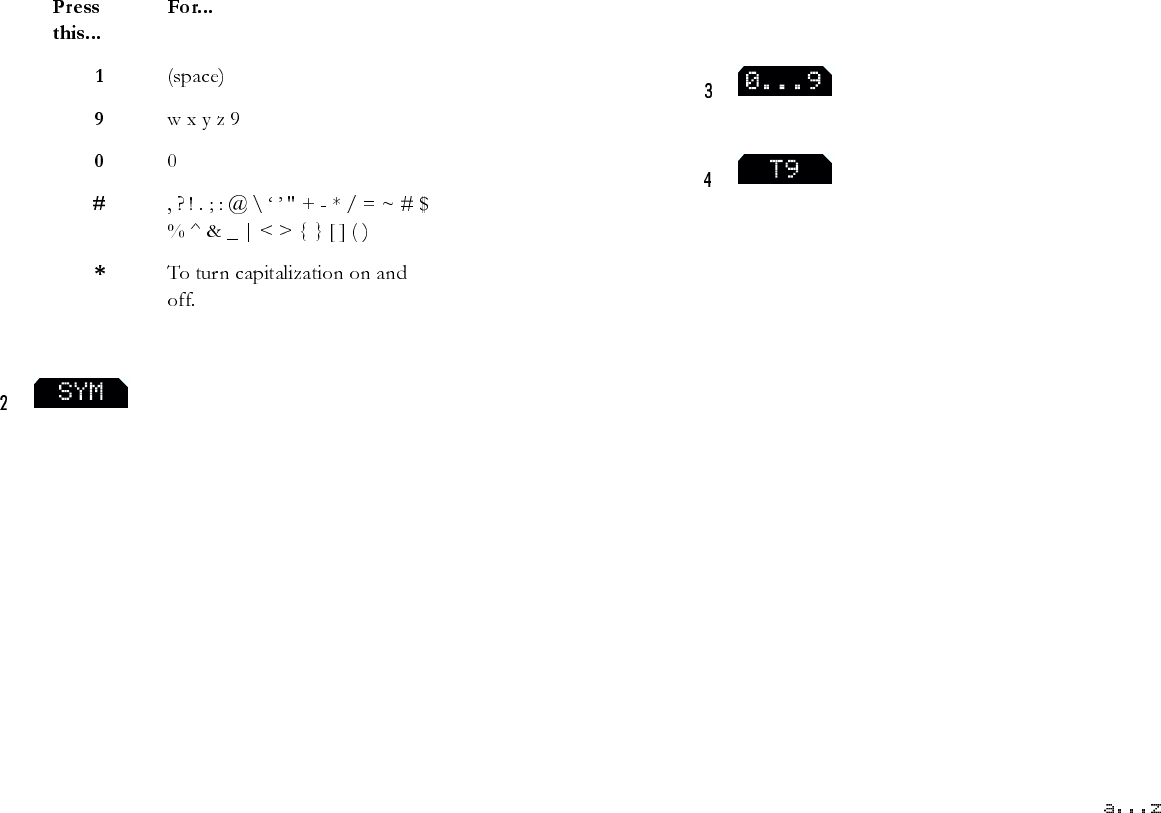
Draft - Not for Commercial Use - Ericsson Inc.
Browser Operation 25
mode allows you to select symbols and punctuation
from a list. You can switch to symbol entry by pressing the right
soft key until SYM is in the right soft key position. There are four
screens of symbols. Press the left soft key to switch between each
screen.
Press the digit key corresponding to the symbol that you want to
enter.
Your phone automatically switches back to the previously-used
method of text entry after you enter one symbol.
mode allows you to enter numbers by pressing the
digit key corresponding to the number that you want to enter.
mode allows you to use Tegic T9 text input. Tegic
T9 text entry software allows you to quickly and easily enter words
or entire sentences with just one key press per letter. Tegic T9 text
entry software uses the phone’s internal dictionary to quickly scan
possible variations to determine the correct word.
Note! T9 will not recognize names, slang terms, or acronyms. You may
wish to add them to your phone’s dictionary.
If you enter all your letters and the word that you want does not
appear, press 0 to view other matches in your phone’s dictionary.
Keep pressing 0 until your word appears.
For example, to enter the word “ball”, press 2, 2, 5, 5. After the first
2, your screen displays “c”. After the second 2, your screen displays
“ca”. After the first 5, your screen displays “cal”. After the second 5,
your screen displays “call”. Press the 0 key until the word “ball” is
displayed.
Note! It may be helpful not to look at the screen until you are finished
entering the characters of the word you are trying to type as a new
word match may occur with each new character entered.
Note! You will know that there is no word match in the T9 dictionary
when your key presses are no longer recognized by T9 text entry
mode. When this happens, backspace, switch to mode, and
continue text entry.
SYM 1 . ? ! , ; : ‘ ’ "
SYM 2 . @ \ / | _ ~ $ ^
SYM 3 + - * / < > = % #
SYM 4 { } [ ] ( ) < > &

Draft - Not for Commercial Use - Ericsson Inc.
26 Browser Operation
If your word does not appear, you can add it into your phone’s dic-
tionary by doing the following:
•Type the text that you want to enter into your phone’s dictionary
by using any of the non-T9 text entry modes.
•With the cursor to the right of the last character (without pressing
a space) reselect T9 mode by pressing the right soft key until T9
appears in the right soft key position.
•Press to enter a space. Your word is added to your phone’s dic-
tionary when your phone is properly powered down.
Exiting the Browser
•Press MENU, then select Exit from the BROWSER menu.
Note! You can also access the Phone’s menu directly from the browser by
pressing, and briefly holding, MENU. From this menu, press BACK to
return to standby.
Note! If there are no pages in cache, the browser will exit and return to
standby when you press BACK from your content provider’s homep-
age.
Tools in the Browser
Once you have launched the browser, you can press MENU to see the
following submenus:
Reload
Select Reload to refresh or reload a page.
Home
Selecting Home will return you to your homepage.
Bookmarks
The Bookmarks submenu will show you the list of bookmarks that
you have set.
Mark Site
Use the Mark Site submenu to set your bookmarks.
About Phone.com
The About Phone.com submenu will display version information
about Phone.com
Advanced...
Show URL - Displays the URL address of the current page.
Homepage - Gives you the option to change your homepage.
Offline Services - Allows WAP content to be stored in the cache,
but not subject to the normal cache reclaiming mechanism.
Outbox - Allows standard WAP transaction requests (such as fetch
new mail, send an instant message, add an appointment) to be
queued and handled as one batch when service is available.
Restart Browser - Clears the cache and restarts the browser.
Encryption - A security code computed by your browser for
authentication. You can verify your encryption with the Verify
Key submenu. You can also select a new encryption key by select-
ing New Key. You should contact your content provider prior to
making any encryption changes.
Exit Browser
Select Exit Browser to return to standby.
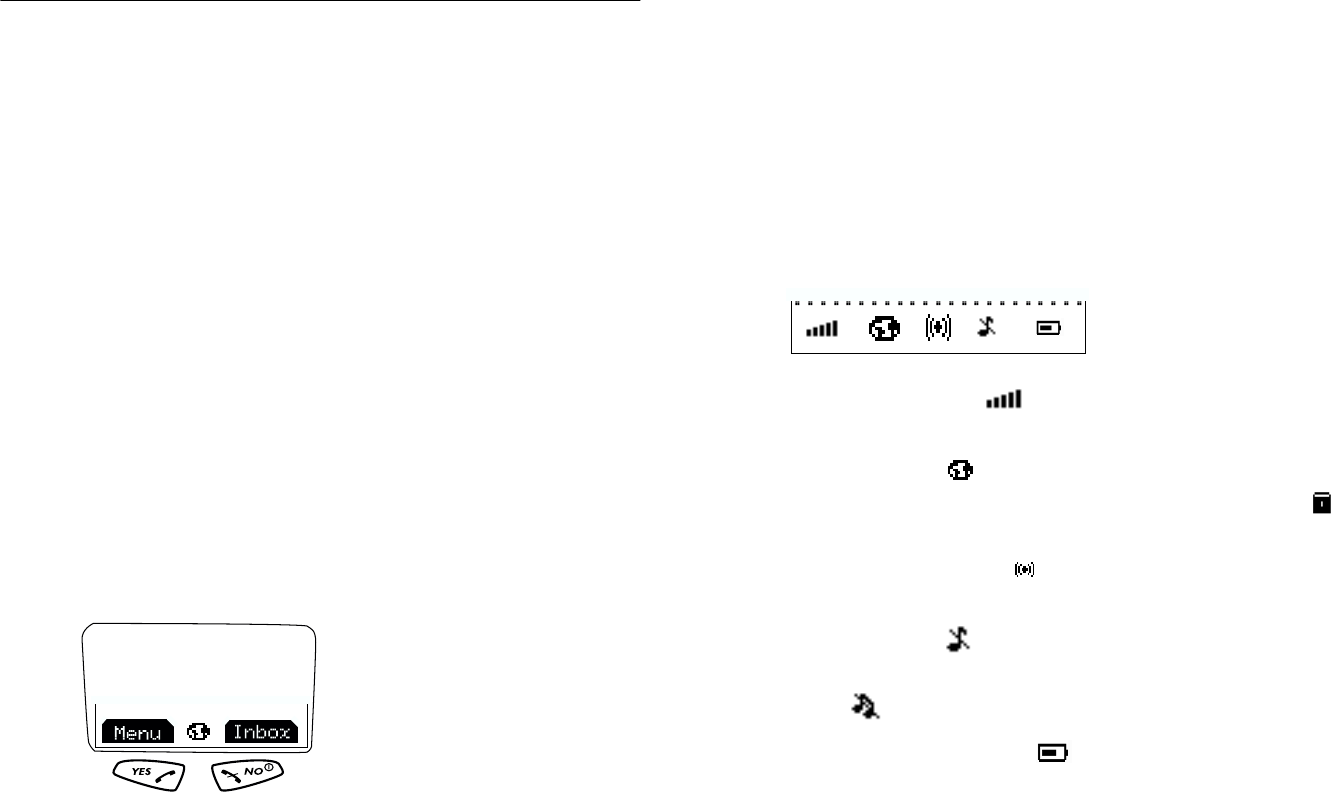
Draft - Not for Commercial Use - Ericsson Inc.
Browser Operation 27
Browser Status
The bottom row on the browser screen displays animation indicating
what is currently happening between the phone and the network.
Text
The following are texts that could possibly appear and their explana-
tions:
• Connecting means that your phone is trying to make a connec-
tion with your content provider.
• Sending means that information is being transmitted from your
handheld browser to your content provider.
• Receiving means that you are receiving information from your
content provider.
•Workingmeans the browser is performing a processor-intensive
operation.
•Waiting means the browser is loading.
Soft Keys
You can use soft keys for action on the current page. They are dis-
played in reverse video on the status bar of your display.
To use the soft key functions, press the left (YES) or right (NO) key
that is under the text label on the screen. The soft keys on your
phone’s screen override the key names. For example, press YES to
select Menu or press NO to select the Inbox.
Note! When using the soft keys, be sure to press and release the YES and
NO keys.Pressing and holding YES sets a bookmark.
Icons
Critical icons are alternated in the center of the soft keys. Other
icons can be viewed by pressing and holding *.
• Signal Strength icon ( ) shows the relative signal strength
from the wireless system. More bars indicate a stronger signal.
•The Globe icon ( ) indicates that you have established a con-
nection with the WAP network. The Secure Connection icon ( )
will replace the globe when a secure connection is established.
•The Browser Alert icon ( ) indicates that there is new content
in your Inbox (for example, email or stock quotes).
• Ringer Off icon ( ) indicates that your phone will not sound an
alert. The Ringer Off icon will be replaced by the Silent Mode
icon ( ) when Silent Mode has been activated.
•The Battery Strength icon ( ) appears, partially full, between
the soft keys when your battery is low. The icon will always appear
when you press and hold *. If the phone is connected to external
......................
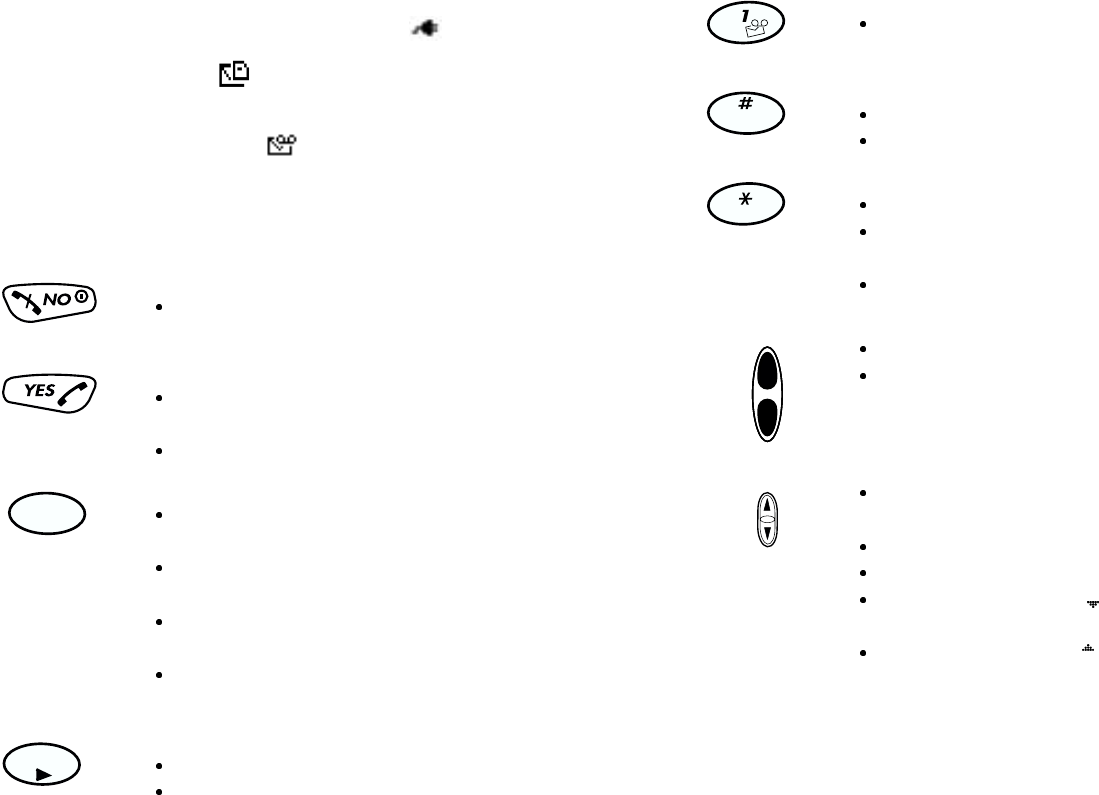
Draft - Not for Commercial Use - Ericsson Inc.
28 Browser Operation
power and the battery is charging, the display alternates between
the battery icon and the charging icon ( ).
•The SMS icon ( ) appears when you receive a text mail mes-
sage.
• The Voice Mail icon ( ) appears when you receive a voice mail
message.
Navigation
NO
Press to select the soft key in the lower right of the
screen.
YES
Press to select the soft key in the lower left of the
screen.
Press and hold to add to the favorites list.
BACK
When entering text, press to erase 1 character to the
left.
When entering text, press and hold to erase the entire
entry.
When not entering text, press to go back one card at a
time.
When not entering text, press and hold to return to
the Home Page.
MENU
Press to go to the Browser menu.
Press and hold to switch to the Voice menu.
BACK
MENU
1/VOICE MAIL
When entering text, press to add a a space in 0...9
mode.
#/POUND
Press to enter symbol characters.
Press and briefly hold to view the time and date.
*/STAR
When entering text, press to toggle capitalization.
Press and briefly hold to show icons such as battery
and signal strength.
Press and briefly hold to see icon display.
SIDE VOLUME KEYS
Press to scroll one screen/page at a time.
Press and briefly hold to autorepeat.
ROCKER KEYS
When entering text, press to move the cursor left or
right.
Press to move up and down within menus.
Press and hold to autorepeat.
When entering text, press to add a space to the end
of a word.
When entering text, press to scroll non-destructively
through the text entered.
,?!
a|A
Draft - Not for Commercial Use - Ericsson Inc.
Browser Operation 29

Draft - Not for Commercial Use - Ericsson Inc.
30 Wireless Modem Operation
Wireless Modem Operation
You can use your phone in Wireless Modem Operation when it is
powered on with the proper cable attached from your phone to your
computer. An Ericsson accessory kit may be required to use your
phone in Wireless Modem Operation. Your phone is in Wireless
Modem Operation when you see the following standby screen.
Your Ericsson mobile phone contains a modem similar to the
modems you use to connect your computer to your home or office
telephone service. Rather than connecting to standard telephone
lines, however, the modem in your mobile phone allows you to con-
nect your computer to the mobile telephone system. In places where
mobile network operators provide the necessary support, you can use
your mobile phone to send or receive faxes, upload or download data
files, or access the Internet.
This chapter will assist you with setting up your computer and
phone to handle data, fax, and Internet calls on the mobile network.
Note! If digital data/fax/Internet service is not available, you can purchase
an analog modem card that is compatible with your Ericsson mobile
phone and use data/fax functions on the available analog system.
Differences Between Data, Fax, and Internet
Calls
Your Ericsson mobile phone can handle data, fax, and Internet calls,
but each type of call requires corresponding software that must be
running on your computer.
Data Calls
Data calls are placed to exchange computer files between two com-
puters. While the data connection is in place, files can be transferred
between the connected computers, according to the capabilities of
the software in use. When a data call is made, the connection will
remain in place until it is closed by one of the computers involved.
To make or receive data calls with your Ericsson mobile phone, you
must have a properly configured communications program running
on your computer.
Fax Calls
Fax calls are placed to send fax messages. When a fax message has
been sent, your fax software or the originating fax machine will ter-
minate the call. To make or receive fax calls with your Ericsson
mobile phone, you must have a properly configured fax program
running on your computer.
Wireless Modem Operation

Draft - Not for Commercial Use - Ericsson Inc.
Wireless Modem Operation 31
Internet Calls
Internet calls are placed to Internet Service Providers (ISP) when you
want to use e-mail or access websites on the World Wide Web. To
make Internet calls, you must have an account with an ISP and a
properly configured Internet access program (browser) running on
your computer. When your software is installed and set up to dial
your ISP, calls can be made using the normal dialing procedure.
Once a connection to your ISP is established, it will remain in place
until you disconnect or until it is automatically disconnected due to
the degradation of signal quality or due to inactivity.
Note! Throughout this chapter, references to data/fax/internet will be
referred to as simply data.
Quick Net Connect
establishes an Internet connection quickly, eas-
ily, and economically. The digital connection bypasses the typically-
used analog modems and connects to the Internet in a matter of sec-
onds.
Before You Start
Before setting up your phone for data operation, do the following:
•Make sure that you have the required hardware and software com-
ponents.
Note! You must have an Ericsson DA 18 Phone Book Manager Accessory
Kit, which includes a serial interface cable, to connect your Ericsson
mobile phone to your computer. The kit also includes a compact
disc with the software required to install your phone as a modem on
your computer.
•Confirm that your mobile service provider supports digital data
services in your planned usage area. If digital data service is not
available, you can purchase an analog modem card that is compat-
ible with your Ericsson mobile phone and use data functions on
the available analog system.
•Verify that you have the necessary subscription.
Note! The availability of digital mobile voice service does not necessarily
imply that your mobile service operator supports digital data opera-
tion.
Setting Up Your Computer
To operate properly with the modem in your Ericsson mobile phone,
make sure that your computer has the following hardware and soft-
ware:
•A functional serial port
•An operating system that supports data access software, such as
Windows 95 or Windows 98
•Appropriate fax (class 2.0), Internet access, or file transfer software
Note! Class “2.0” is different from Class “2”.
Initial Setup
Successful first-time setup of your phone and computer for data
operation involves the following steps:
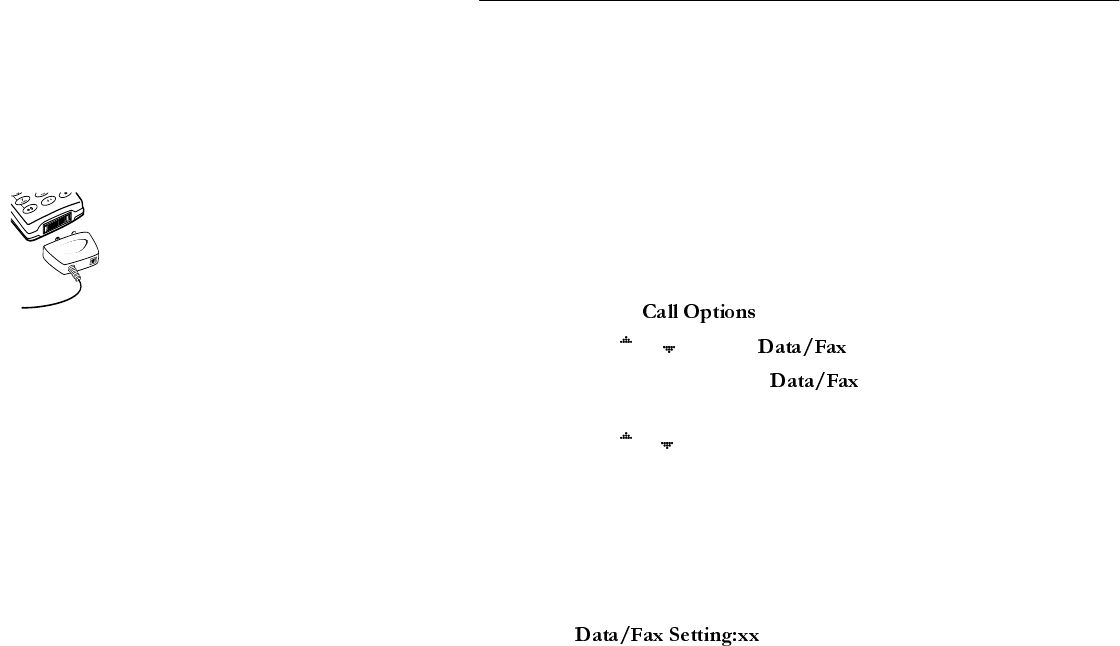
Draft - Not for Commercial Use - Ericsson Inc.
32 Wireless Modem Operation
1 Connect Your Computer to Your Phone
Your Ericsson DA 18 Phone Book Manager Accessory Kit con-
tains a serial interface cable. The cable has a plug on one end that
matches the receptacle on the bottom of your Ericsson mobile
phone. The other end of the cable has a 9-pin female connector
that matches the standard 9-pin serial interface port connector.
Connect one end of the cable to your Ericsson mobile phone and
the other end to the serial port on your computer.
Note! If you are trying to connect to a 25-pin serial interface port on your
computer, you will need an adapter. You can purchase a 25-pin serial
interface port adapter at most computer supply stores.
2 Install Your Modem Control Software (driver)
The modem control software (driver) that you need to use your
Ericsson mobile phone is available on the compact disc included
in your DA 18 Phone Book Manager Accessory Kit. Refer to the
Installing Your Modem Driver From Your Compact Disc section
at the end of this chapter for help with installing drivers for some
operating systems. When the appropriate driver is loaded, refer to
the sections on making and receiving data and fax calls later in this
chapter.
3 Set up your data access software according to the instructions sup-
plied with it.
Operation
Receiving Data and Fax Calls
Review the instructions from your mobile service provider that
describe the procedures and rules for making and receiving data calls
in your area. If you are having trouble receiving a data call, you may
need to configure your phone manually to receive a data call. To
configure your phone manually, do the following:
1 Set up your phone and computer as described above.
2 Press MENU from the Standby screen to access the main menu.
3 Choose from the SETTINGS menu.
4 Press or until the is highlighted.
5 Press YES to open the . The current selection is indi-
cated by a filled radio button.
6 Press or until the call type for the next call you will receive is
highlighted. Call Types are: Off, Next Call Fax, Fax On, Next Call
Data, and Data On.
Note! The Off setting is active until you choose a different setting. Fax On
and Data On apply until you power off your phone.
7 Press YES to select the highlighted call type.
8 appears in the display. Your phone is now
configured to a specific type for your next incoming call.
Making Data and Fax Calls
When your phone and computer are properly set up, you can send a
fax, or initiate data calls, as with any other modem.
ERICSSONZ
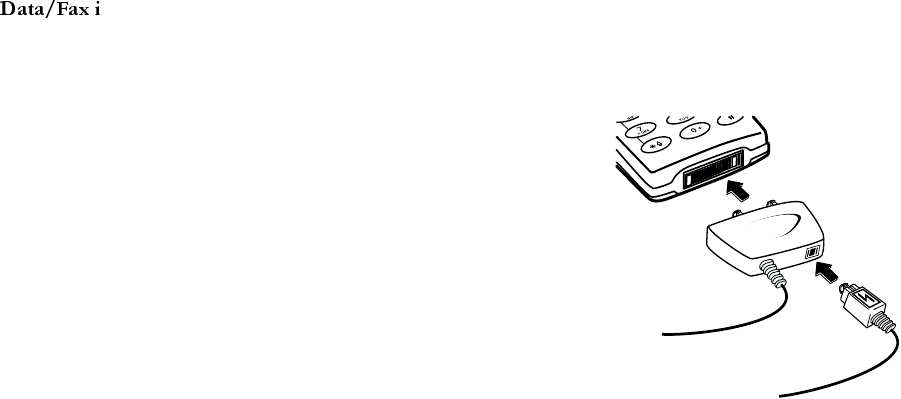
Draft - Not for Commercial Use - Ericsson Inc.
Wireless Modem Operation 33
Review the instructions from your mobile service provider that
describe the procedures and rules for making and receiving data calls
in your area.
Note! To avoid unnecessary airtime charges, terminate your data calls as
soon as you have finished transferring files by pressing the NO key.
Some software can be set to do this automatically.
Making Voice Calls While Connected to Your Computer
You can originate voice calls when you are not on a data call. You can
receive voice calls if s set to Off.
Your Ericsson mobile phone enables you to initiate voice calls from
Windows applications when connected to the Ericsson Voice Call
Dialer. This is particularly useful if you have contact cards with
phone numbers in a contact management application. You can open
a contact card, click on the phone icon, and originate a call using
your Ericsson mobile phone. Then you simply pick up your mobile
phone and continue the call. The Ericsson Voice Call Dialer is com-
patible with most contact manager software packages. Refer to the
“Manual Installation of Your Modem Driver” or “Voice Call Dialer”
section at the end of this chapter for help with installing this driver
for some operating systems.
Disconnecting
Disconnect your Ericsson mobile phone from your computer by dis-
connecting the cable from your phone and the serial port from your
computer.
Use With Other Ericsson Accessories
Rapid or Travel Charger
To charge your phone’s battery with an Ericsson rapid or travel
charger during data operation, do the following:
1 Plug one end of the cable from your DA 18 Phone Book Manager
Accessory Kit into your phone.
2 Plug the other end of the cable from your DA 18 Phone Book
Manager Accessory Kit into the serial port on your computer.
3 Plug the charger cable into the bottom of the connector from your
DA 18 Phone Book Manager Accessory Kit cable.
4 Plug the charger cable into the wall outlet.
Desktop Charger
To charge your phone’s battery with an Ericsson desktop charger
during data operation, do the following:
1 Plug one end of the cable from your DA 18 Phone Book Manager
Accessory Kit into the back of your desktop charger.
ERICSSONZ

Draft - Not for Commercial Use - Ericsson Inc.
34 Wireless Modem Operation
2 Plug the other end of the cable from your DA 18 Phone Book
Manager Accessory Kit into the serial port on your computer.
3 Plug the charger cable into the bottom of the connector from your
DA 18 Phone Book Manager Accessory Kit cable.
4 Plug your charger cable into the wall outlet.
5 Insert the phone into the front compartment of your desktop
charger.
Achieving Best Performance
Charging your Battery
Both your Ericsson mobile phone and your laptop computer batter-
ies should be well-charged before starting data operation. This will
help you avoid interruptions due to loss of power.
You may charge your phone’s battery with an Ericsson charger dur-
ing data/fax operation as mentioned above.
Signal Strength
It is important to maintain a good signal path between the phone
and the mobile telephone system when making data calls. Signals
will generally be stronger when the phone is in an upright position.
If you are indoors, your signal will generally be stronger when the
phone is near a window.
In a Vehicle
It is possible to receive data calls from your vehicle. Operation from a
moving vehicle may not be satisfactory because data may be lost
when your call is transferred from one mobile base station to
another. Be sure to give full attention to driving and pull off the road
and park before making or receiving calls, if driving conditions so
require.
Transmission Disturbances
Brief interruptions of mobile telephone signals that would not be
bothersome during a voice call may cause problems during data
operation, depending upon the error correction capabilities of the
software being used. Such interruptions are uncommon during sta-
tionary operation, but can be caused by vehicles or people passing
nearby, especially in areas of low signal strength. You can use the sig-
nal strength indicator on your phone to verify that you have a good
signal path.
Installing Your Modem Driver From Your
Compact Disc
Windows 95
Complete the following steps to install the appropriate modem
driver (INF file) on your computer if you are running Windows 95:
1 Turn On your Ericsson mobile phone.
2 Connect one end of your serial cable to your Ericsson mobile
phone and the other end to your computer’s serial port.
3 Restart your computer. Windows will autodetect your Ericsson
mobile phone. When your desktop returns, insert the compact
disc from your DA 18 Phone Book Manager Accessory Kit. One
of the following screens will appear:

Draft - Not for Commercial Use - Ericsson Inc.
Wireless Modem Operation 35
• New Hardware Found
When the New Hardware Found screen appears, choose Driver
from disk provided by your hardware manufacturer and click OK.
At the Install from Disk screen, type D:\ in the box then click OK
(if your CD-ROM drive is not drive D, type the correct CD-
ROM drive designation).
• Update Device Driver Wizard
When the Update Device Driver Wizard appears, click Next.
Once Windows has found the driver, click Finish.
Note! If neither the New Hardware Found nor the Update Device Driver
Wizard screens appear, refer to the Manual Installation Instructions
at the end of this chapter.
4 When your desktop returns, verify that your modem is properly
installed. From the Start menu on your Windows desktop, click
on Settings, then Control Panel. Double-click the Modems icon.
5 When the Modem Properties screen appears, click on the descrip-
tion of your modem and click the Diagnostics tab. Note the
COM port to which your modem is assigned.
6 Click OK to proceed.
Windows 98
Complete the following steps to install the INF file on your com-
puter if you are running Windows 98:
1 Turn On your Ericsson mobile phone.
2 Connect one end of your serial cable to your Ericsson mobile
phone and the other end to your computer’s serial port.
3 Restart your computer. Windows will autodetect your Ericsson
mobile phone. When your desktop returns, insert the compact
disc from your DA 18 Phone Book Manager Accessory Kit.
4 When the Add New Hardware Wizard screen appears, click Next.
Note! If the Add New Hardware Wizard screen does not appear, refer to
the Manual Installation Instructions at the end of this chapter.
5 Select Search for the best driver for your device (recommended)
and click Next.
6 Select the appropriate CD-ROM drive and click Next.
7 When Windows is now ready to install the best driver for this
device appears, click Next.
8 When Windows has finished installing the software that your
new hardware device requires appears, click Finish.
9 When your desktop returns, verify that your modem is properly
installed. From the Start menu on your Windows desktop, click
on Settings, then Control Panel. Double-click the Modems icon.
10 When the Modem Properties screen appears, click on the
description of your modem and click the Diagnostics tab. Note
the COM port to which your modem is assigned.
11 Click OK to proceed.
Manual Installation of Your Modem Driver or
Voice Call Dialer
Complete the following steps to manually install the INF file on
your computer if you are running Windows 95/98
1 Turn On your Ericsson mobile phone.
2 Connect one end of your serial cable to your Ericsson mobile
phone and the other end to your computer’s serial port.

Draft - Not for Commercial Use - Ericsson Inc.
36 Wireless Modem Operation
3 From the Start menu on your Windows desktop, click on Set-
tings, then Control Panel. Double-click the Modems icon.
4 Click Add.
5 At the Install New Modem screen, select Other. Click Next.
6 At the next Install New Modem screen, select Don’t run Hard-
ware Installation Wizard then click Next.
7 At the next Install New Modem screen, select Don’t detect my
modem, I will select it from a list then click Next.
8 At the next Install New Modem screen, click on Have Disk.
9 At the Install from Disk screen, select D:\ at Copy from Manufac-
turer’s Disk (if your CD-ROM drive is not drive D, type the cor-
rect CD-ROM drive designation).
10 At the Install New Modem screen, select Ericsson Voice Call
Dialer, then click Next.
11 Select the COM port to which your Ericsson mobile phone is
connected and click Next.
12 When Your modem has been set up successfully appears, click
Finish.
13 When your desktop returns, verify that your modem is properly
installed. From the Start menu, click on Settings, then Control
Panel. Double-click the Modems icon.
14 When the Modem Properties screen appears, click on the
description of your modem and click the Diagnostics tab. Note
the COM port to which your modem is assigned.
15 Click OK to proceed.
Troubleshooting
1 You cannot set up or maintain a data/fax session.
This will occur if you are inadvertently originating a voice call
when attempting a data/fax call. To correct the problem, do the
following:
a From the Start menu on your Windows desktop, click on Set-
tings, then Control Panel.
b Double-click the Modems icon.
c Select the General tab.
d Select Ericsson CDMA Data/Fax Modem from the pull-down
list.
e Click Properties.
f Click General. Make sure that the maximum speed is set to
19200.
g Select the Connection tab.
h Click Advanced.
i In the Extra settings box, type the following:
&C1+CRM=0;
j Click OK to return to the Connection tab.
k Click OK to return to Modem Properties.
l Click Close.
Note! If you are using an application that supplies its own box for entering
extra settings, then type the following command string into that box
as well:
+COS=4,1,2,0; +ES=1,0,1; +DS=0,0,512,6;
2 You cannot originate a voice call.
a From the Start menu on your Windows desktop, click on Set-
tings, then Control Panel.
b Double-click the Modems icon.
c Select the General tab.
Draft - Not for Commercial Use - Ericsson Inc.
Wireless Modem Operation 37
d Select Ericsson Voice Call Dialer from the pull-down list.
e Click Properties.
f Select the Connection tab.
g Click Advanced.
h Type the following in the Extra Settings box of the the
Advanced Connection Settings window:
*ERVNOK=1
i Click OK to return to the Connection tab.
j Click OK to return to Modem Properties.
k Click Close.
3 You are having trouble initiating data/fax calls from your com-
puter.
Check to see if your COM ports are occupied. If so, you must
temporarily disable the software applications that are using the
COM ports.

Draft - Not for Commercial Use - Ericsson Inc.
38 Troubleshooting
s
Problem Solving
Troubleshooting
My phone does
not turn On.
My phone does
not ring when a
call is received.
My battery does
not charge to full
capacity.
My signal strength
varies.
____
I cannot connect
to the modem.

Draft - Not for Commercial Use - Ericsson Inc.
Troubleshooting 39
Accessories, Accessibility, and Internet
Technical Assistance/Ordering Accessories
•North America - 1-800 ERICSSON (1-800-374-2776)
•Latin America - 305-755-6789
•Other countries - 919-472-7908
Accessible Solutions/Special Needs
For information on Accessible Solutions for individuals with special
needs call the Ericsson Special Needs Center at 877-878-1996
(TTY) or 877-207-2056 (voice), or visit the Ericsson Special Needs
Center at http://www.ericsson-snc.com
Internet
Visit Ericsson on the internet at: http://mobile.ericsson.com
I am having prob-
lems downloading
information.

Draft - Not for Commercial Use - Ericsson Inc.
40 Guidelines for Safe and Efficient Use
Since its introduction in the mid 1980s, the mobile phone has been
one of the most exciting and innovative products ever developed.
Your phone can help you to stay in touch with your office, your
home, emergency services and others.
Safety
Exposure to Radio Frequency Signals
Your wireless handheld portable telephone is a low power radio
transmitter and receiver. When it is ON, it receives and also sends
out radio frequency (RF) signals.
In August, 1996, the Federal Communications Commission (FCC)
adopted RF exposure guidelines with safety levels for handheld wire-
less phones. Those guidelines are consistent with the safety standards
previously set by both US and international standards bodies:
•ANSI C95.1 (1992)*
•NCRP Report 86 (1986)*
•ICNIRP (1996)*
Those standards were based on comprehensive and periodic evalua-
tions of the relevant scientific literature. For example, over 120 scien-
tists, engineers, and physicians from universities, government health
agencies, and industry reviewed the available body of research to
develop the ANSI Standard (C95.1).
The design of your phone complies with the FCC guidelines (and
those standards).
* American National Standards Institute: National Council on Radia-
tion Protection and Measurements; International Commission on Non-
Ionizing Radiation Protection.
Antenna Care
Use only the supplied or an approved replacement antenna. Unau-
thorized antennas, modifications, or attachments could damage the
phone and may violate FCC regulations.
Phone Operation
NORMAL POSITION: Hold the phone as you would any other
telephone with the antenna pointed up and over your shoulder.
TIPS ON EFFICIENT OPERATION: For your phone to operate
most efficiently:
•Extend your antenna fully (where applicable).
•Do not touch the antenna unnecessarily when the phone is in use.
Contact with the antenna affects call quality and may cause the
phone to operate at a higher power level than otherwise needed.
Driving
Check the laws and regulations on the use of wireless telephones in
the areas where you drive. Always obey them. Also, if using your
phone while driving, please:
Guidelines for Safe and Efficient Use

Draft - Not for Commercial Use - Ericsson Inc.
Guidelines for Safe and Efficient Use 41
•Give full attention to driving - driving safely is your first responsi-
bility.
•Use handsfree operation, if available.
•Pull off the road and park before making or answering a call if
driving conditions so require.
In addition, Ericsson suggests the following safe driving tips if you
are using your phone while driving:
•Get to know your wireless phone and its features such as speed dial
and redial.
•Position your wireless phone within easy reach.
•Suspend conversations during hazardous driv-
ing conditions or situations.
•Do not take notes or look up phone numbers
while driving.
•Dial sensibly and assess the traffic; if possible,
place calls when you are not moving or before
pulling into traffic.
•Do not engage in stressful or emotional conversations that may be
distracting.
•Use your wireless phone to call for help.
•Use your wireless phone to help others in emergencies.
•Call roadside assistance or a special wireless non-emergency assis-
tance number when necessary.
Electronic Devices
Most modern electronic equipment is shielded from RF signals.
However, certain electronic equipment may not be shielded against
RF signals from your wireless phone.
Pacemakers
The Health Industry Manufacturers Association recommends that a
minimum separation of six (6”) inches be maintained between a
handheld wireless phone and a pacemaker to avoid potential inter-
ference with the pacemaker. These recommendations are consistent
with the independent research by and recommendations of Wireless
Technology Research.
Persons with pacemakers:
•Should ALWAYS keep the phone more than six inches from their
pacemaker when the phone is turned ON.
•Should not carry the phone in a breast pocket.
•Should use the ear opposite the pacemaker to minimize the poten-
tial for interference.
•If you have any reason to suspect that interference is taking place,
turn your phone OFF immediately.
Hearing Aids
Some digital wireless phones may interfere with some hearing aids.
In the event of such interference, you may want to consult your ser-
vice provider (or call the customer service line to discuss alterna-
tives).
Other Medical Devices
If you use any other personal medical device, consult the manufac-
turer of your device to determine if it is adequately shielded from
external RF energy. Your physician may be able to assist you in
obtaining this information.
Turn your phone OFF in health care facilities when any regulations
posted in these areas instruct you to do so. Hospitals or health care

Draft - Not for Commercial Use - Ericsson Inc.
42 Guidelines for Safe and Efficient Use
facilities may be using equipment that could be sensitive to external
RF energy.
Vehicles
RF signals may affect improperly installed or inadequately shielded
electronic systems in motor vehicles. Check with the manufacturer
or its representative regarding your vehicle. You should also consult
the manufacturer of any equipment that has been added to your
vehicle.
Posted Facilities
Turn your phone OFF in any facility where posted notices so
require.
Aircraft
FCC regulations prohibit using your phone while in the air. Switch
OFF your phone before boarding an aircraft.
Blasting Areas
To avoid interfering with blasting operations, turn your phone OFF
when in a “blasting area” or in areas posted: “Turn off two-way
radio.” Obey all signs and instructions.
Potentially Explosive Atmospheres
Turn your phone OFF when in any area with a potentially explosive
atmosphere and obey all signs and instructions. Sparks in such areas
could cause an explosion or fire resulting in bodily injury or even
death.
Areas with a potentially explosive atmosphere are often but not
always clearly marked. They include fueling areas such as gasoline
stations; below deck on boats; fuel or chemical transfer or storage
facilities; vehicles using liquefied petroleum gas (such as propane or
butane); areas where the air contains chemicals or particles, such as
grain, dust, or metal powders; and any other area where you would
normally be advised to turn off your vehicle engine.
For Vehicles Equipped with an Air Bag
An air bag inflates with great force. DO NOT place objects, includ-
ing both installed or portable wireless equipment, in the area over
the air bag or in the air bag deployment area. If in-vehicle wireless
equipment is improperly installed and the air bag inflates, serious
bodily injury could result.
Product Care and Operation
This device complies with Part 15 of the FCC Rules. Operation is
subject to the following two conditions: 1) This device may not
cause harmful interference, and 2) This device must accept any
interference received, including interference that may cause undes-
ired operation.
Ericsson suggests you read and observe the following for safe care
and operation of your phone:
•Do not allow children to play with your phone. They could hurt
themselves or others, or could accidentally damage the phone.
Your phone may contain small parts that could be detached and
create a choking hazard.
•Do not expose your mobile phone to moisture or extreme temper-
atures.

Draft - Not for Commercial Use - Ericsson Inc.
Guidelines for Safe and Efficient Use 43
•Only Ericsson original accessories are recommended. Failure to
use them may result in loss of performance or product damage,
and will void the warranty.
•Do not attempt to disassemble the product. Doing so will void
warranty. This product does not contain consumer serviceable
components. Service should only be performed by Authorized Ser-
vice Centers.
•Do not allow objects to fall on, or liquids to spill on products.
•Connect AC (power supply) only to designated power sources as
marked on the product.
•To reduce risk of damage, remove the electrical cord from the out-
let by pulling the AC adapter at the outlet rather than the cord.
•Make sure the electric cord is located so that it will not be stepped
on, tripped over, or otherwise subjected to damage or stress.
•To reduce risk of electric shock, unplug the unit from the power
source before attempting any cleaning. Once unplugged, use a soft
cloth lightly dampened with water for cleaning.
•DANGER - Never alter the AC cord or plug. If the plug will not
fit into the outlet, have a proper outlet installed by a qualified elec-
trician. Improper connection can result in risk of electric shock.
•Don’t twist the antenna. Excess twisting will damage the antenna.
Battery Information
New Batteries
The battery packaged with your phone is not fully charged. For max-
imum battery capacity, use your charger to condition the battery.
Recycling Your Battery
Your phone manufacturer is a member of the Rechargeable Battery
Recycling Corporation (RBRC), a non-profit service organization
designed to assist in the recycling of rechargeable batteries. Many
areas require the recycling of rechargeable batteries. In the U.S., call
1-800-822-8837 to find out how to recycle your battery. Outside the
U.S., contact your local retailer for recycling instructions.
Battery Use and Care
A rechargeable battery has a long service life if treated properly. A
new battery, or one that has not been used for a long period of time,
should be conditioned before using your phone. Avoid recharging a
fully-charged or almost fully-charged battery. If your phone shuts off
due to low battery power, you should charge the battery within 24
hours for the battery to reach full capacity.
•Do not leave your battery where it may be subjected to extremely
hot or cold temperatures. This could reduce the battery’s capacity.
•Do not let the metal contacts on the battery touch another metal
object such as keys in your pocket. This could short-circuit and
damage the battery.
•Do not attempt to take a battery apart.
•Do not expose a battery to open flame. This could cause the bat-
tery to explode.
•Turn your phone OFF before removing the battery.
•Use only the AC/DC adapter supplied with your battery charger.
Using a different adapter could be dangerous and will void your
phone warranty.
•Never charge a battery when the ambient room temperature is
below 50° F (10°C) or above 105°F (40°C).

Draft - Not for Commercial Use - Ericsson Inc.
44 Guidelines for Safe and Efficient Use
•Do not allow the battery to be placed into the mouth. Battery
electrolytes may be toxic if swallowed.
FDA Consumer Update
FDA has been receiving inquiries about the safety of mobile phones,
including cellular phones and PCS phones.
The following summarizes what is known--and what remains
unknown--about whether these products can pose a hazard to health,
and what can be done to minimize any potential risk. This informa-
tion may be used to respond to questions.
Why the concern?
Mobile phones emit low levels of radiofrequency energy (i.e., radiof-
requency radiation) in the microwave range while being used. They
also emit very low levels of radiofrequency energy (RF), considered
non-significant, when in the stand-by mode. It is well known that
high levels of RF can produce biological damage through heating
effects (this is how your microwave oven is able to cook food). How-
ever, it is not known whether, to what extent, or through what mech-
anism, lower levels of RF might cause adverse health effects as well.
Although some research has been done to address these questions, no
clear picture of the biological effects of this type of radiation has
emerged to date. Thus, the available science does not allow us to
conclude that mobile phones are absolutely safe, or that they are
unsafe. However, the available scientific evidence does not demon-
strate any adverse health effects associated with the use of mobile
phones.
What kinds of phones are in question?
Questions have been raised about hand-held mobile phones, the
kind that have a built-in antenna that is positioned close to the user’s
head during normal telephone conversation. These types of mobile
phones are of concern because of the short distance between the
phone’s antenna--the primary source of the RF--and the person’s
head. The exposure to RF from mobile phones in which the antenna
is located at greater distances from the user (on the outside of a car,
for example) is drastically lower than that from hand-held phones,
because a person’s RF exposure decreases rapidly with distance from
the source. The safety of so-called “cordless phones,” which have a
base unit connected to the telephone wiring in a house and which
operate at far lower power levels and frequencies, has not been ques-
tioned.
How much evidence is there that hand-held mobile
phones might be harmful?
Briefly, there is not enough evidence to know for sure, either way;
however, research efforts are on-going. The existing scientific evi-
dence is conflicting and many of the studies that have been done to
date have suffered from flaws in their research methods. Animal
experiments investigating the effects of RF exposures characteristic
of mobile phones have yielded conflicting results. A few animal stud-
ies, however, have suggested that low levels of RF could accelerate
the development of cancer in laboratory animals. In one study, mice
genetically altered to be predisposed to developing one type of cancer
developed more than twice as many such cancers when they were
exposed to RF energy compared to controls. There is much uncer-
tainty among scientists about whether results obtained from animal
studies apply to the use of mobile phones. First, it is uncertain how
to apply the results obtained in rats and mice to humans. Second,
Draft - Not for Commercial Use - Ericsson Inc.
Guidelines for Safe and Efficient Use 45
many of the studies that showed increased tumor development used
animals that had already been treated with cancer-causing chemicals,
and other studies exposed the animals to the RF virtually continu-
ously--up to 22 hours per day.
For the past five years in the United States, the mobile phone indus-
try has supported research into the safety of mobile phones. This
research has resulted in two findings in particular that merit addi-
tional study:
1 In a hospital-based, case-control study, researchers looked for an
association between mobile phone use and either glioma (a type of
brain cancer) or acoustic neuroma (a benign tumor of the nerve
sheath). No statistically significant association was found between
mobile phone use and acoustic neuroma. There was also no associ-
ation between mobile phone use and gliomas when all types of
types of gliomas were considered together. It should be noted that
the average length of mobile phone exposure in this study was less
than three years.
When 20 types of glioma were considered separately, however, an
association was found between mobile phone use and one rare
type of glioma, neuroepithelliomatous tumors. It is possible with
multiple comparisons of the same sample that this association
occurred by chance. Moreover, the risk did not increase with how
often the mobile phone was used, or the length of the calls. In fact,
the risk actually decreased with cumulative hours of mobile phone
use. Most cancer causing agents increase risk with increased expo-
sure. An ongoing study of brain cancers by the National Cancer
Institute is expected to bear on the accuracy and repeatability of
these results.1
2 Researchers conducted a large battery of laboratory tests to assess
the effects of exposure to mobile phone RF on genetic material.
These included tests for several kinds of abnormalities, including
mutations, chromosomal aberrations, DNA strand breaks, and
structural changes in the genetic material of blood cells called lym-
phocytes. None of the tests showed any effect of the RF except for
the micronucleus assay, which detects structural effects on the
genetic material. The cells in this assay showed changes after expo-
sure to simulated cell phone radiation, but only after 24 hours of
exposure. It is possible that exposing the test cells to radiation for
this long resulted in heating. Since this assay is known to be sensi-
tive to heating, heat alone could have caused the abnormalities to
occur. The data already in the literature on the response of the
micronucleus assay to RF are conflicting. Thus, follow-up research
is necessary.2
FDA is currently working with government, industry, and aca-
demic groups to ensure the proper follow-up to these industry-
funded research findings. Collaboration with the Cellular Tele-
communications Industry Association (CTIA) in particular is
expected to lead to FDA providing research recommendations and
scientific oversight of new CTIA-funded research based on such
recommendations.
Two other studies of interest have been reported recently in the liter-
ature:
1 Two groups of 18 people were exposed to simulated mobile phone
signals under laboratory conditions while they performed cogni-
tive function tests. There were no changes in the subjects’ ability
to recall words, numbers, or pictures, or in their spatial memory,
but they were able to make choices more quickly in one visual test
when they were exposed to simulated mobile phone signals. This
was the only change noted among more than 20 variables com-
pared.3
Draft - Not for Commercial Use - Ericsson Inc.
46 Guidelines for Safe and Efficient Use
2 In a study of 209 brain tumor cases and 425 matched controls,
there was no increased risk of brain tumors associated with mobile
phone use. When tumors did exist in certain locations, however,
they were more likely to be on the side of the head where the
mobile phone was used. Because this occurred in only a small
number of cases, the increased likelihood was too small to be sta-
tistically significant.4
In summary, we do not have enough information at this point to
assure the public that there are, or are not, any low incident health
problems associated with use of mobile phones. FDA continues to
work with all parties, including other federal agencies and industry,
to assure that research is undertaken to provide the necessary answers
to the outstanding questions about the safety of mobile phones.
What is known about cases of human cancer that have
been reported in users of hand-held mobile phones?
Some people who have used mobile phones have been diagnosed
with brain cancer. But it is important to understand that this type of
cancer also occurs among people who have not used mobile phones.
In fact, brain cancer occurs in the U.S. population at a rate of about
6 new cases per 100,000 people each year. At that rate, assuming 80
million users of mobile phones (a number increasing at a rate of
about 1 million per month), about 4800 cases of brain cancer would
be expected each year among those 80 million people, whether or
not they used their phones. Thus it is not possible to tell whether
any individual’s cancer arose because of the phone, or whether it
would have happened anyway. A key question is whether the risk of
getting a particular form of cancer is greater among people who use
mobile phones than among the rest of the population. One way to
answer that question is to compare the usage of mobile phones
among people with brain cancer with the use of mobile phones
among appropriately matched people without brain cancer. This is
called a case-control study.
The current case-control study of brain cancers by the National Can-
cer Institute, as well as the follow-up research to be sponsored by
industry, will begin to generate this type of information.
What is FDA’s role concerning the safety of mobile
phones?
Under the law, FDA does not review the safety of radiation-emitting
consumer products such as mobile phones before marketing, as it
does with new drugs or medical devices. However, the agency has
authority to take action if mobile phones are shown to emit radiation
at a level that is hazardous to the user. In such a case, FDA could
require the manufacturers of mobile phones to notify users of the
health hazard and to repair, replace or recall the phones so that the
hazard no longer exists.
Although the existing scientific data do not justify FDA regulatory
actions at this time, FDA has urged the mobile phone industry to
take a number of steps to assure public safety. The agency has recom-
mended that the industry:
•support needed research into possible biological effects of RF of
the type emitted by mobile phones;
•design mobile phones in a way that minimizes any RF exposure to
the user that is not necessary for device function; and
•cooperate in providing mobile phone users with the best possible
information on what is known about possible effects of mobile
phone use on human health.
At the same time, FDA belongs to an interagency working group of
the federal agencies that have responsibility for different aspects of

Draft - Not for Commercial Use - Ericsson Inc.
Guidelines for Safe and Efficient Use 47
mobile phone safety to ensure a coordinated effort at the federal
level. These agencies are:
•National Institute for Occupational Safety and Health
•Environmental Protection Agency
•Federal Communications Commission
•Occupational Health and Safety Administration
•National Telecommunications and Information Administration
The National Institutes of Health also participates in this group.
In the absence of conclusive information about any pos-
sible risk, what can concerned individuals do?
If there is a risk from these products--and at this point we do not
know that there is--it is probably very small. But if people are con-
cerned about avoiding even potential risks, there are simple steps
they can take to do so. For example, time is a key factor in how
much exposure a person receives. Those persons who spend long
periods of time on their hand-held mobile phones could consider
holding lengthy conversations on conventional phones and reserving
the hand-held models for shorter conversations or for situations
when other types of phones are not available.
People who must conduct extended conversations in their cars every
day could switch to a type of mobile phone that places more distance
between their bodies and the source of the RF, since the exposure
level drops off dramatically with distance. For example, they could
switch to:
•a mobile phone in which the antenna is located outside the vehi-
cle,
•a hand-held phone with a built-in antenna connected to a differ-
ent antenna mounted on the outside of the car or built into a sep-
arate package, or
•a headset with a remote antenna to a mobile phone carried at the
waist.
Again, the scientific data does not demonstrate that mobile phones
are harmful. But if people are concerned about the radiofrequency
energy from these products, taking the simple precautions outlined
above can reduce any possible risk.

Draft - Not for Commercial Use - Ericsson Inc.
48 Guidelines for Safe and Efficient Use
Where can I find additional information?
For additional information, see the following websites:
• Federal Communications Commission (FCC) RF Safety Program
(select “Information on Human Exposure to RF Fields from Cel-
lular and PCS Radio Transmitters”)
http://www.fcc.gov/oet/rfsafety
• World Health Organization (WHO) International Commission
on Non-Ionizing Radiation Protection (select Qs & As)
http://www.who.int/emf
• United Kingdom, National Radiological Protection Board
http://www.nrpb.org.uk
• Cellular Telecommunications Industry Association (CTIA)
http://www.wow-com.com
• U.S. Food and Drug Administration (FDA) Center for Devices
and Radiological Health
http://www.fda.gov/cdrh/consumer/
Footnotes
1 Muscat et al. Epidemiological Study of Cellular Telephone Use
and Malignant Brain Tumors. In: State of the Science Sympo-
sium;1999 June 20; Long Beach, California.
2 Tice et al. Tests of mobile phone signals for activity in genotoxicity
and other laboratory assays. In: Annual Meeting of the Environ-
mental Mutagen Society; March 29, 1999, Washington, D.C.;
and personal communication, unpublished results.
3 Preece, AW, Iwi, G, Davies-Smith, A, Wesnes, K, Butler, S, Lim,
E, and Varey, A. Effect of a 915-MHz simulated mobile phone sig-
nal on cognitive function in man. Int. J. Radiat. Biol., April 8,
1999.
4 Hardell, L, Nasman, A, Pahlson, A, Hallquist, A and Mild, KH.
Use of cellular telephones and the risk for brain tumors: a case-
control study. Int. J. Oncol., 15: 113-116, 1999.
Draft - Not for Commercial Use - Ericsson Inc.
Guidelines for Safe and Efficient Use 49

Draft - Not for Commercial Use - Ericsson Inc.
50 Glossary
Calling Line Identification (CLI)
CLI shows the number of the person calling you in your mobile
phone display. You can then make an informed choice as to whether
or not to take the call. Bear in mind that not all numbers can be dis-
played. To use this service, it must be supported by your network.
Content Provider
A company that provides web services to mobile phone subscribers.
The Content Provider may be the same as the Service Provider.
DTMF or Touch Tone
Dual Tone Multi Frequency signal – codes sent as tone signals. Used
for telephone banking, for accessing an answering machine, etc.
Encryption
A security code computed by your browser for authentication.
EZ-Read™ Menus
EZ-Read™ Menus make menu navigation and changing settings
simple. The tabbed menus clearly show the way.
Fax Class
Standards for fax transmission are set as classes. Class I and II allow
data transfer speeds of between 2400 up to 9600 bps.
Forward or Call Forward
Enables you to forward calls to another number, for example your
voicemail or home phone.
Handsfree
An important safety feature for mobile phones that allows drivers to
use their car phone without lifting or holding the handset to their
ear.
Menu System
The easiest way to access all the phone’s functions. The menus are
arranged to be accessed and viewed when scrolling with the arrow
keys.
Number Assignment Module (NAM)
Your NAM is the storage of your phone number or phone numbers
and any network parameters. The NAM identifies your phone to
your service provider.
Network
A mobile phone network or system consists of a network of cells. A
radio base station serves each cell from where calls are forwarded to
and received from your mobile phone by wireless radio signals.
Glossary

Draft - Not for Commercial Use - Ericsson Inc.
Glossary 51
Operator
To be able to use your phone, you need a subscription to a network.
You get this subscription from a network operator.
Phone Book
A memory in your mobile phone where phone numbers can be
stored and accessed by name (alpha memory search) or position.
Personal Identification Number (PIN)
Your PIN is a code used for all phones to establish authorization for
access to certain functions or information. The PIN code comes
with your subscription.
Preferred Roaming List (PRL)
The PRL is defined by your service provider so that your phone will
automatically search for optional networks when your primary net-
work is not available. These predefined networks typically offer bet-
ter rates than non-preferred networks. Preferred networks are
indicated with an
R
.
Restrict Calls
Enables you to restrict certain or all types of calls to and from your
mobile phone, for example, outgoing calls, outgoing international
calls, incoming calls. Restricting is activated with a personal code. To
use this service, it must be supported by your network.
Roaming
You are outside of your home network.
Semi-Duplex
In handsfree equipment, full duplex means that the connection is
open for both parties to talk simultaneously. Semi-duplex gives close
to, but not complete, duplex functionality.
Service Provider
Like a Content Provider, your Service Provider provides network
access to mobile phone users. The Service Provider and Content Pro-
vider may be the same.
Short Message Service (SMS)
SMS allows messages of up to 239 characters to be sent and received
via the network operator’s message center to your mobile phone.
Messages are stored if the phone is off or out of reach ensuring that
they reach you. To use this service, it must be supported by your net-
work.
Scroll
Pressing or to move between the menus.
Select
Scrolling to a menu then pressing the YES key on the phone.
Soft Keys
Soft Keys are virtual keys that have varying functionality in Browser
Mode. The soft keys are shown in the display above the YES and NO
keys; however, you use the YES and NO keys to operate the soft key
functions.
Draft - Not for Commercial Use - Ericsson Inc.
52 Glossary
Standby
The mode where your phone has been cleared of all menu items and
features.
Subscription
Is the contract that you have with the service/network provider. To
use your phone, you need to have a subscription to a network. The
services included in your subscription depend on your choice of
operator and/or subscription. So some of the services and functions
described in this manual may not be accessible to you. If you want a
complete list of the services included in your subscription, please
contact your network operator.
Voicemail
A computerized answering service that automatically answers your
call, plays a greeting in your own voice and records a message.

Draft - Not for Commercial Use - Ericsson Inc.
Index 53
A
Accessibility39
Accessible Solutions39
Accessing Menus9
Accessories39
Add
Phonebook Entry10
Adjusting Ear Volume16
Analog/Digital Indicator8
Auto Answer13
Auto Retry13
B
Backlight14
Battery
Charging5
Icon8
Low Battery Alert16
Browser
Menu14
Operation22
C
Call Forwarding17
Call Info Menu11
Clear Call Lists12
Outgoing Calls11
Caller Number Identification18
Charging5
Battery5
Charge-Only Mode5
Slow Charging6
D
Data Calls30
Data/Fax/Internet Calls
Achieving Best Performance34
Disturbances34
In Vehicles34
Initial Setup31
Making32
Operation32
Receiving32
Delete
All Phonebook Entries10
All Text Messages11
Display
Backlight14
Banner14
Browser Operation23
Time Format14
Voice Operation8
Display Messages
Voice Operation9
Document Conventions1
E
Ear Volume12
Adjusting16
Edit
Phonebook Entries10
Entering
Letters and Symbols18
Ericsson
Accessories3958
Contacting39
Internet39
F
Fax Calls30
H
Home Usage11
I
Icon
Battery8
Browser Alert8
Index
Draft - Not for Commercial Use - Ericsson Inc.
54 Index
Keypad Lock8
New Text Mail8
New Voice Mail8
Phone Silent827
Ringer Off8
Secure Connection27
Signal Strength927
International Calls18
Internet39
Internet Calls31
K
Key Functions
Voice Operation21
Key Sound12
Keypad Lock12
Keypad Lock Icon8
L
Letters
Entering1824
Low Battery16
M
Main Menu9
Menus
Accessing9
Message Alert12
Messages Menu
Delete All11
Voice Mail10
Modem Drivers35
Muting
Microphone17
Ring Tone16
N
New
Text Mail Icon8
Voice Mail Icon8
O
Operation
Browser22
Voice8
Wireless Modem3038
Outgoing Calls11
P
Phone
Silent8
Phonebook
Creating Phonebook Entries18
Entering Letters and Symbols18
Phonebook Menu1628
Add Entry10
Delete All Entries10
Edit Entry10
Problem38
Battery Will Not Charge38
Low Battery Power38
No Service38
Out Of Range38
Phone Does Not Ring38
Phone Does Not Turn On38
Signal Strength Varies38
Solving38
Text Message Memory Full38
Weak Signal38
R
Redialing the Last Number16
Ring Sound12
Ringer Off8
Ringer Off Icon27
Roam Usage12
S
Secure Connection Icon27
Settings Menu12
Signal Strength Icon927
Silent Mode Icon27
Slow6
Sounds Submenu12
Special Needs39
Status Messages
Connecting...27
Draft - Not for Commercial Use - Ericsson Inc.
Index 55
Receiving...27
Sending...27
Waiting...27
Working...27
Stop and Pause Dialing17
Super Speed Dial13
Symbols24
Entering18
T
Text Entry
Tegic T925
Total Usage12
TTY Phone Number39
U
Usage
Home11
Roam12
Total12
V
Voice
Mail10
Voice Calls16
Call Forwarding17
Placing16
Redialing16
Stop and Pause Dialing18
Voice Operation8
W
Wireless Modem Operation3038
Before You Start38
Problem Solving38
Draft - Not for Commercial Use - Ericsson Inc.
56 Index

Draft - Not for Commercial Use - Ericsson Inc.
AE/LZT 123 5633 R1
1 List and Call
2 Add Entry
3 List and Edit
4 My Number
5 Find Entry
6 Scratchpad
7 Auto Hyphenate
8 Delete All Entries
1 Voice Mail
2 Message Inbox
3 Message Outbox
4 Send Message
5 Memory Used
6 Delete All
1 Call List
2 Home Usage
3 Roam Usage
4 Total Usage
5 Clear Call Lists
1 Sounds
2 My Number
3 Keypad Lock
4 Call Options
5 Security
6 Language
7 Display
8 System Options
1 Launch Browser
2 Text Size
3 Alert Sound
4 Network
Menus can be selecting from the menu button. A quicker way to access menus and submenus is
to use the associated numbers. For instance, to access your press MENU 2 2.

Draft - Not for Commercial Use - Ericsson Inc.
A1228c Quick Card
Emergency Calls:
Enter 911 (or 112) and press YES to call.
Back Up One Level in Menu Mode
Press NO
Scroll Through Menus
Press or
Select a Menu or Save a Setting
Press YES
Speed Dial
Enter position number (1-99) and press
YES
Redial Last Dialed Number
Press YES from Standby
Website
http://mobile.ericsson.com
Technical Support
North America -1-800 ERICSSON
Latin America - 305-755-6789
Other Countries - 919-472-7908
Turn Phone On/Off
Press and hold NO
Answer Call
Press YES
End Call
Press NO
Call Voicemail
Press and hold 1
Call Number Shown in Display
Press YES
Change Ear Volume (During Call)
Press upper or lower side key
Microphone Mute (During Call):
Press and hold BACK
Keypad Lock:
Press MENU *
Silent Mode:
Press MENU #